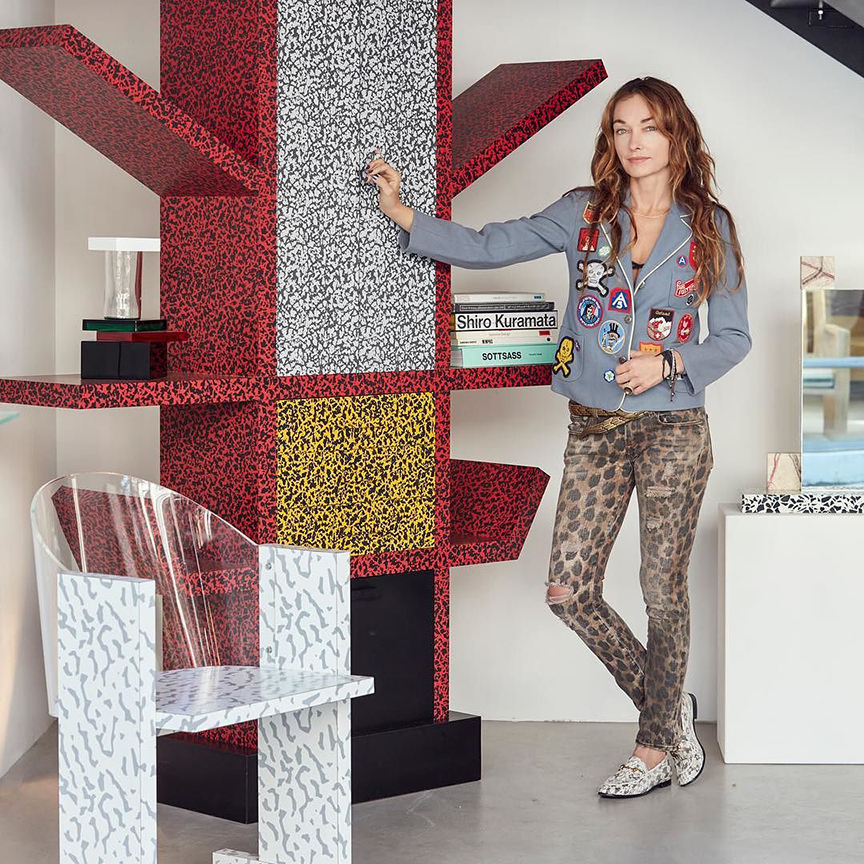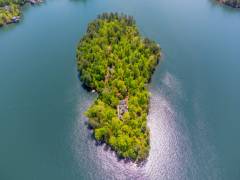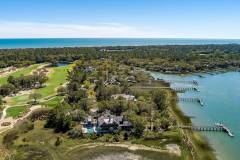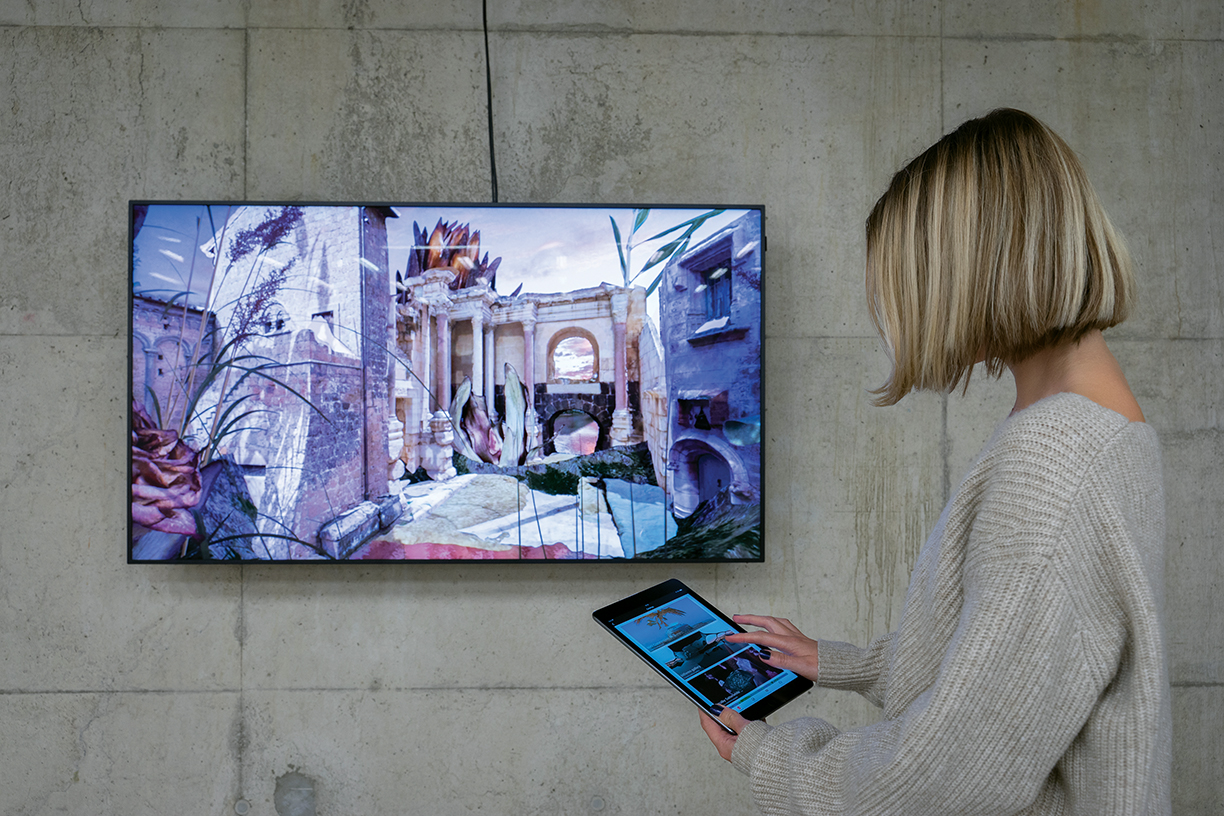
Photo courtesy Niio.
Smart technologies and artificial intelligence are changing the way we consume art.
While many treasured works of art are safely contained in notable museums or in the homes of experienced collectors, a new tide is cresting along the shores of the art curation field with the influx of digital art.
Digital art, more widely known as new media art, is an interesting sector of the art industry to define, even for Beryl Graham, who is a professor in New Media Art at the University of Sunderland. She notes that the roots of this art form have drawn inspiration from a range of movements, from conceptual artwork to video art, which also began in the 1960s.
“It’s broadly digital but [it’s also] the kind of art that works in different ways in different kinds of behaviors,” Graham notes. One fascinating example would be an exhibition of software art in which the software, sometimes even artificial intelligence-based artwork, can learn and grow on its own. Graham explains that an artist might start a piece of software and watch it evolve, perhaps give it a virus and watch, showing to the audience that the “end point isn’t quite under the control of the artist.”
Magdalena “Magda” Sawon, owner of the contemporary art gallery Postmasters Gallery in New York, says that the digital age has only heightened the senses of curators and artists, who are traditionally at the forefront of new developments in culture and technology.
“Technology is a tool,” she notes, “it is also a moving target and changing constantly. The question is to be aware of new developments and adapt it intelligently to one’s needs and benefit.” Fittingly, as artists have been harnessing the power of technology within the art industry, curators and galleries have had to “keep up with the times,” and embrace digital forms of artwork and the systems and methods in which they are displayed.
Donna Holford-Lovell, director of The North East of North festival (NEoN), notes how the incorporation of interaction and participation into art displays appeals to today’s technology-savvy audiences that have been gradually reinvigorating focus on the digital art world.
“The idea of ‘curation’ has become ubiquitous and our audience is seen to be curating many aspects of their own lives,” Holford-Lovell says. NEoN is an organized event that aims to advance the understanding and accessibility of digital and technology-driven art forms by having the artist and curator work together to translate “the spectacle of experience,” via digital platforms within physical spaces, like virtual reality, artificial intelligence, and even social media.
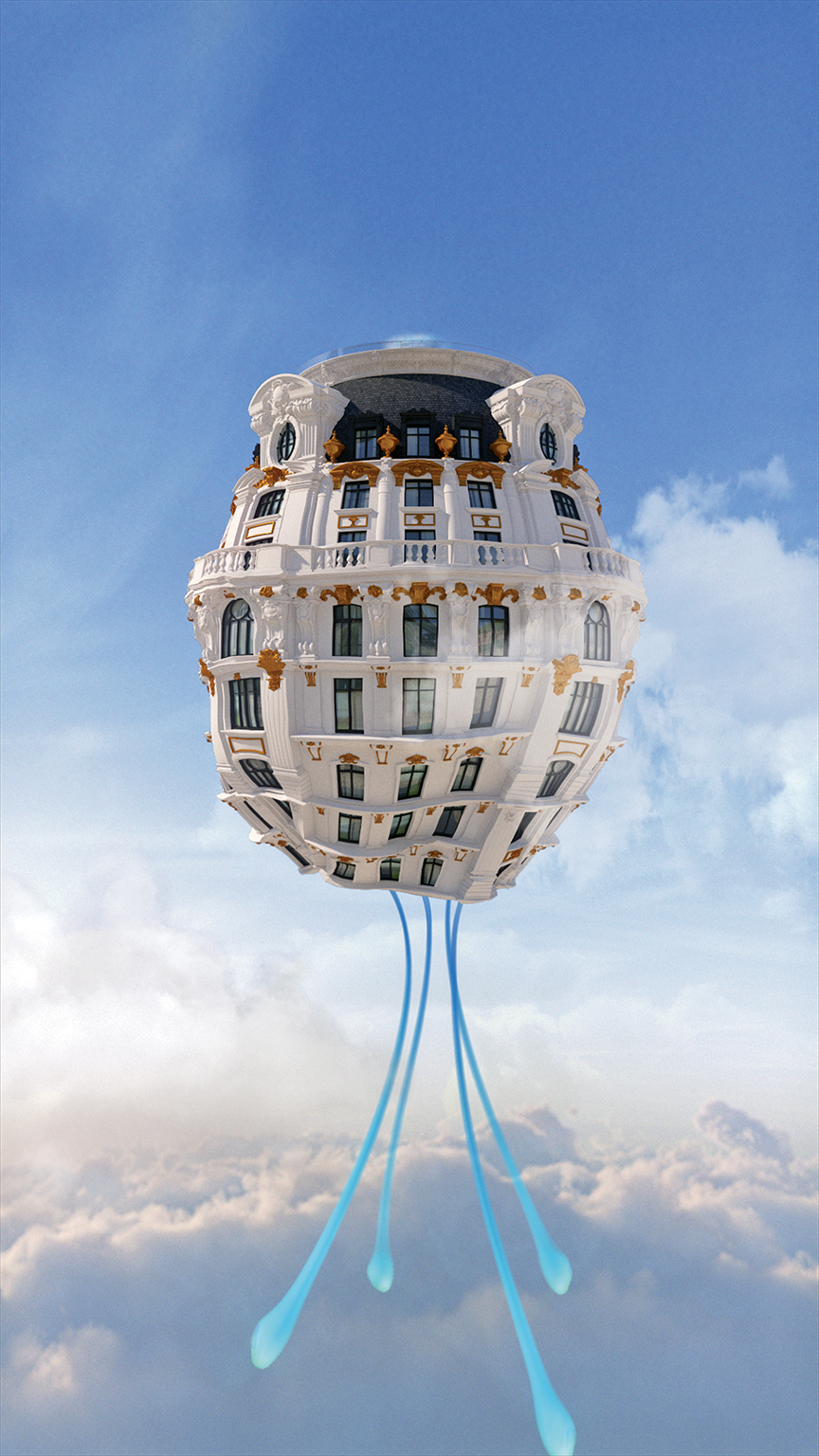
JONATHAN MONAGHAN (US)
The Phoenix and the Medusa (2018), Video, 7 min 69 sec, Edition of 30, Niio Commission Series.
With systems and platforms, from artificial intelligence to online-based forums, both artists and curators now are developing larger platforms and databases to contribute toward. As well as an educator, Graham is co-founder and editor of the Curatorial Resource for Upstart Media Bliss, or CRUMB, a resource for curators of new media art that aims to help overcome any challenges presented from this rise in digital art, from installations to networks of artists and individuals versed in these practices.
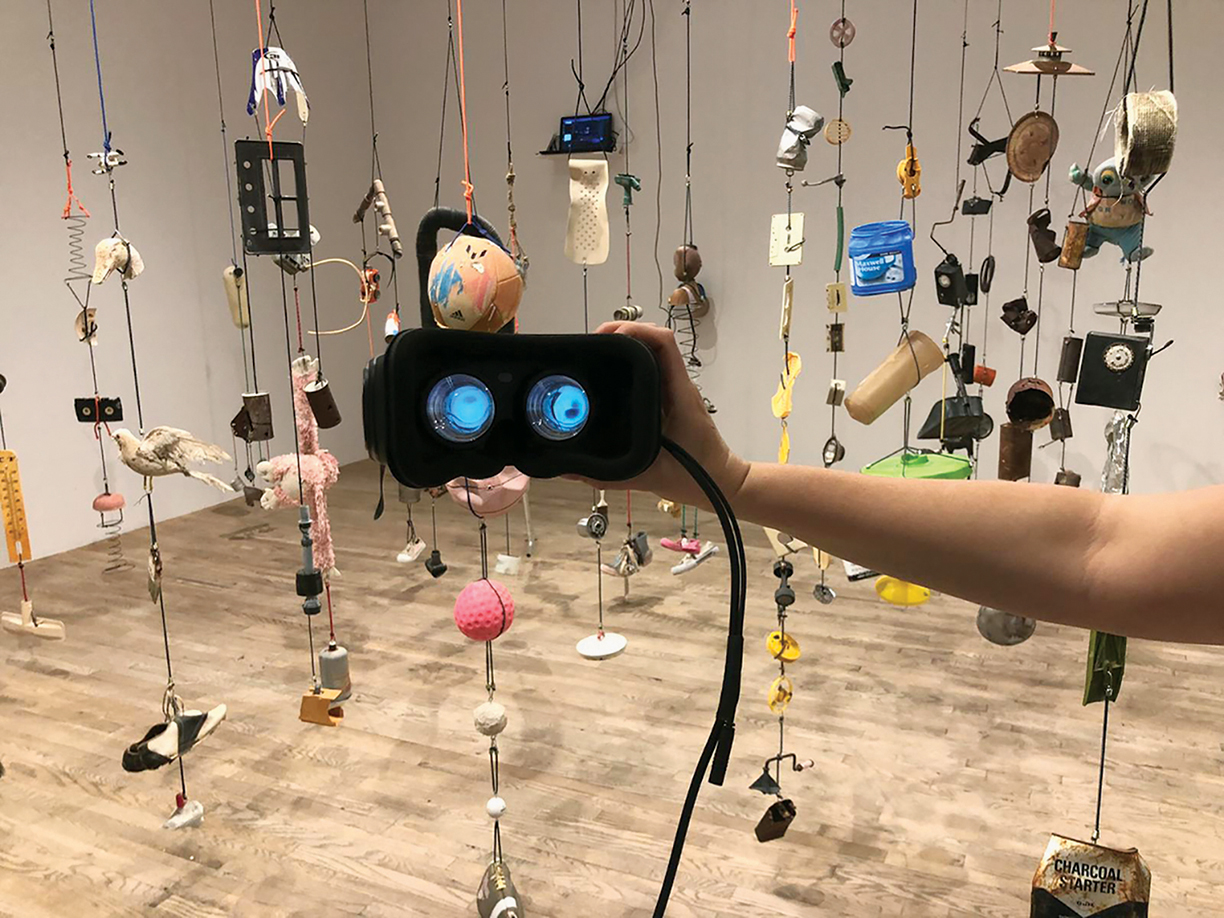
PERRY HOBERMAN
Suspensions (2018), VR and mixed reality installation, Postmasters April 2018.
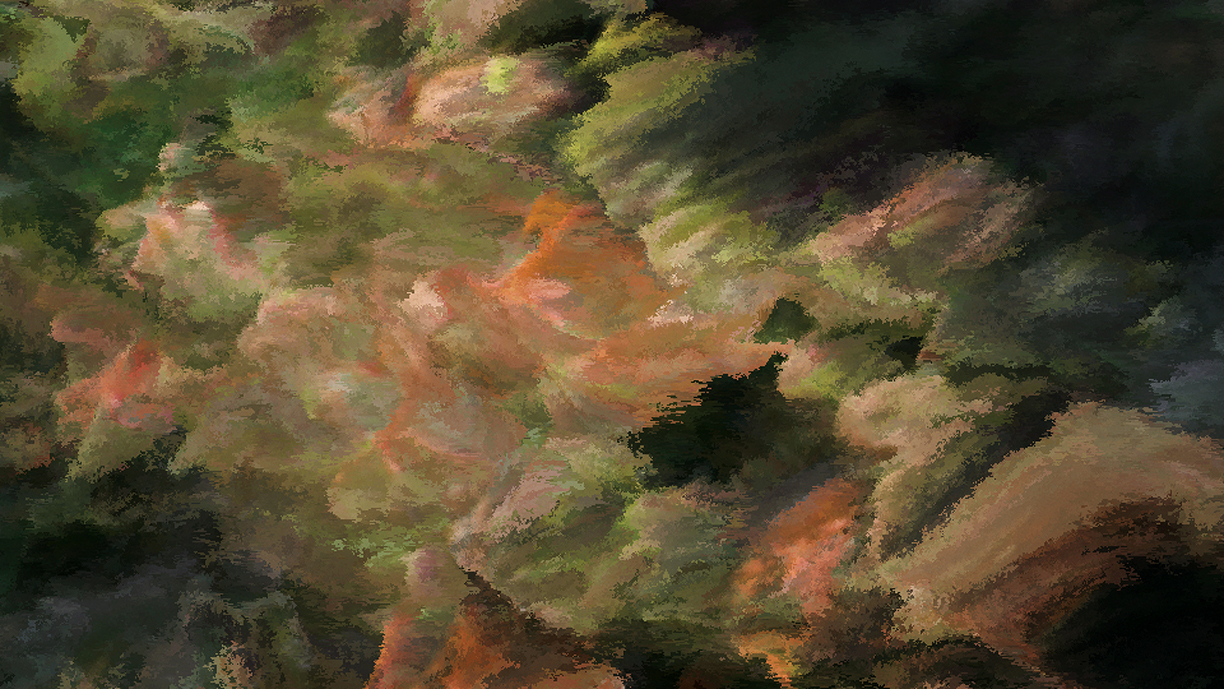
QUAYOLA (UK)
Camouflage (2018), Moving Image, 6 min 4 sec, Edition of 30, Niio Commission Series
On the luxury spectrum of art curation, Niio is a brand integrating digital art and technology-driven forms of collection and distribution that surges past the limitations of traditional artwork. Niio is an art and tech company aimed to enable the exposure of digital artwork in a time that to the company feels like a fourth industrial revolution.
“Art has always reflected the world we live in,” says Rob Anders, CEO and co-founder of Niio, “and artists will create their art with any tool they can access.” In today’s world, that tool has come to be technology. Anders, who understands the eclectic background of digital art from conceptual and video art, wanted to help designers and architects best fit homes with the art of today, and after speaking with top galleries he found that what’s really needed are new models of both the business and technological side that reach a broader audience — even better: one with a subscription.
“We envision a world where in homes people will have more digital canvases with interactive or immersive works, all on a centralized connected system that can very easily change,” Anders says, with access to top artists in the world in this ecosystem of artists, galleries and collections all on the Niio platform. Luckily, the CEO notes, the technology is “already there,” from artificial intelligence in devices like Amazon’s Alexa devices to smart televisions, all devices that can easily work with the Niio platform to display digital artwork.
To those interested in having access to the “world’s finest art accessible on-demand,” Niio is open as a limited edition membership at about $5,000 a month, with access to curated exhibitions and collections, or art “playlists” of over 7,500 art pieces on the platform that can be easily changed and displayed on devices like smart TVs, projectors, screens, et cetera, which can be installed by Niio technicians as well.
“Art curation is telling a particular story,” he says. “In order to give people these digital works, it’s not about just finding the individual works, it’s about giving people the ability to learn about the works they are looking at,” he says.
New York designer Aimée Wilder explores Eudaimonia, a Greek word commonly translated as happiness or “human flourishing,” in her collection of wallpapers, fabrics, rug and accessories. From the effects of the moon on the evolution of the natural world to the impact of astrological phenomenon, Wilder captures the many ways surroundings can influence our psychological state, and contribute to overall wellness.
“This collection was born through finding balance and stability in my own life,” says Wilder. “Once I learned that living to work instead of working to live, along with incorporating methods like Vedic meditation and natural healing into my daily routine, was able to create a peaceful environment around me, I hoped to thoughtfully reflect that feeling in each design.”
Eudaimonia consists of two wallpaper and fabric patterns, Pyramide du Soleil and Earthlight, with an additional rug pattern, Eclipse. All three patterns reflect the natural balance between the Earth, the Sun, and the Moon, evoking the beauty of cosmic balance. With this collection, Wilder introduces a new construction for commercial fabrics, tested for 50,000 double rubs and available with a range of protective coatings including anti-microbial and stain coating. In addition, for the first time, Wilder will offer wallpaper printed in Brooklyn, New York, where she resides and operates her design studio.
Pyramide du Soleil is a subtly optical pattern manifesting the ancient Sun’s shadow and its balance with the earth, Pyramide du Soleil features pyramid and Sun as they represent the illusive quality of time. It integrates pyramids and circles with sophisticated diagonals and horizontal stripes, inspired by the continuous synchronicity that exists between the earth and the Moon.
Earthlight focuses on the waxing and waning cycles of the Moon’s phases in an eye-catching, geometric pattern across wallpaper and fabric design. Named for the scientific phenomenon in which sunlight reflected from Earth’s surface indirectly illuminates the otherwise dark side of the Moon, Earthlight is sure to brighten any space.
Eclipse showcases the inversion of colors in this rug design suggests the effects of an Eclipse, a harbinger of change in the daily life that acts as a guiding hand when questioning one’s path. With a boldness that invokes a new take on a vintage aesthetic, the Eclipse rug comes in a range of warm tones that will add a welcoming touch to a room.
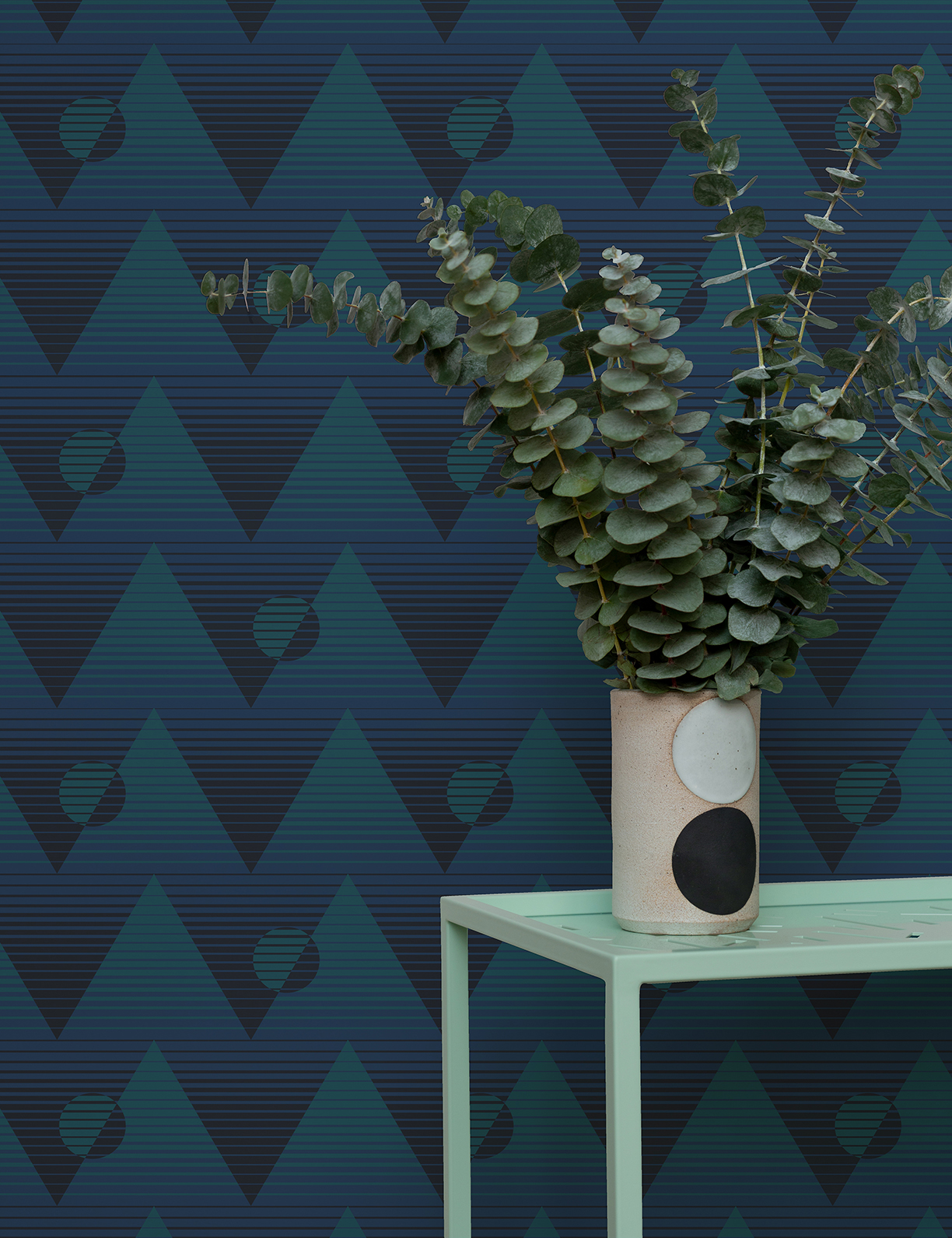
Pyramide du Soleil
Photos courtesy Aimee Wilder.

Eclipse
Photo by ©Dylan Chandler 2018.
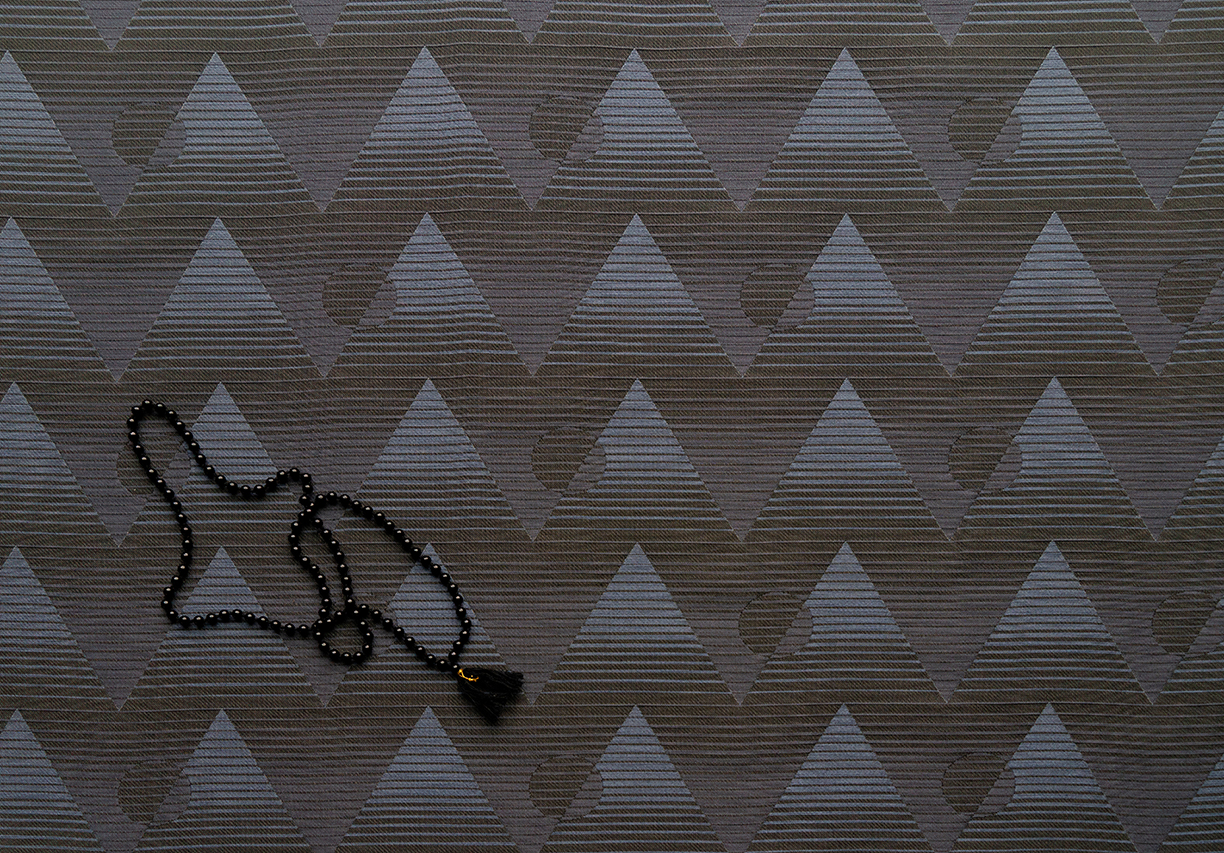
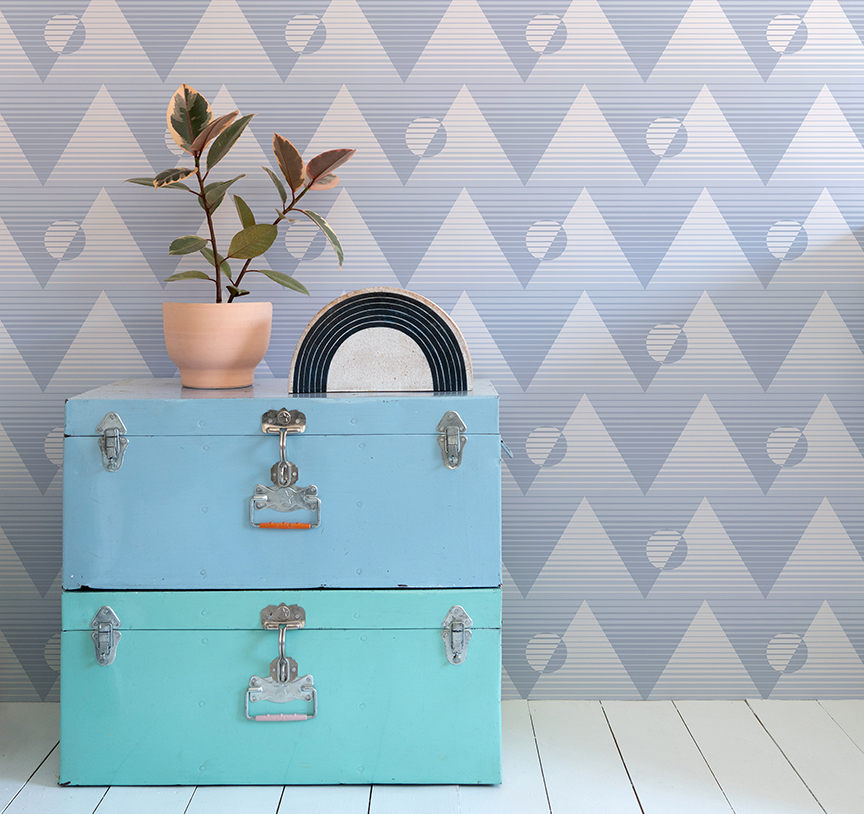
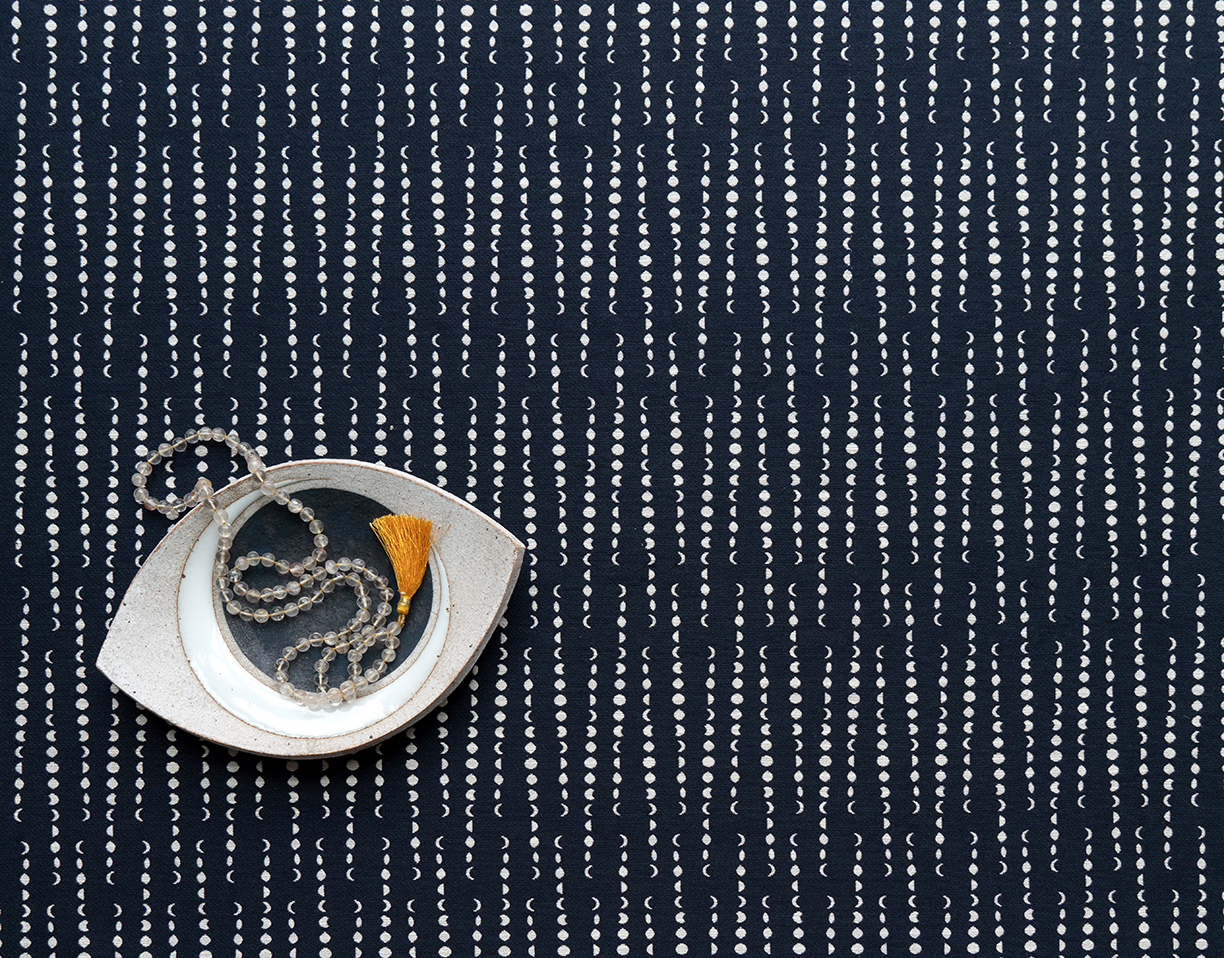
Earthlight
Photos courtesy Aimee Wilder.
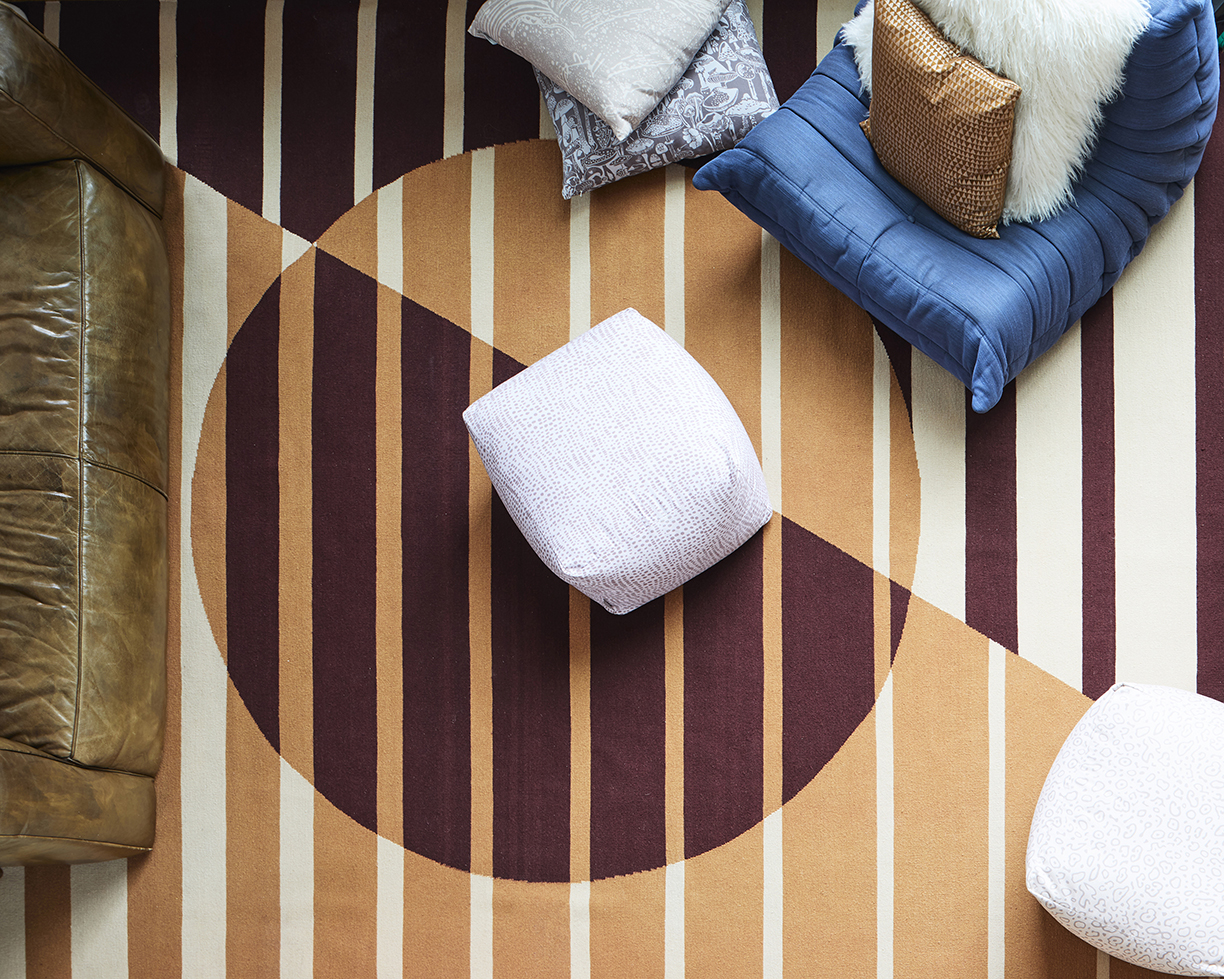
Thermador, the iconic luxury home and kitchen appliance brand, is kicking off its fourth Kitchen Design Challenge, with new categories and prizes, allowing professional designers, builders, architects, remodelers, kitchen dealers and — for the first time in Thermador contest history — students to get involved.
All 44 of the regional winners will also win a trip for two to the exclusive gala in Southern California in 2020, where the national winners will be announced.
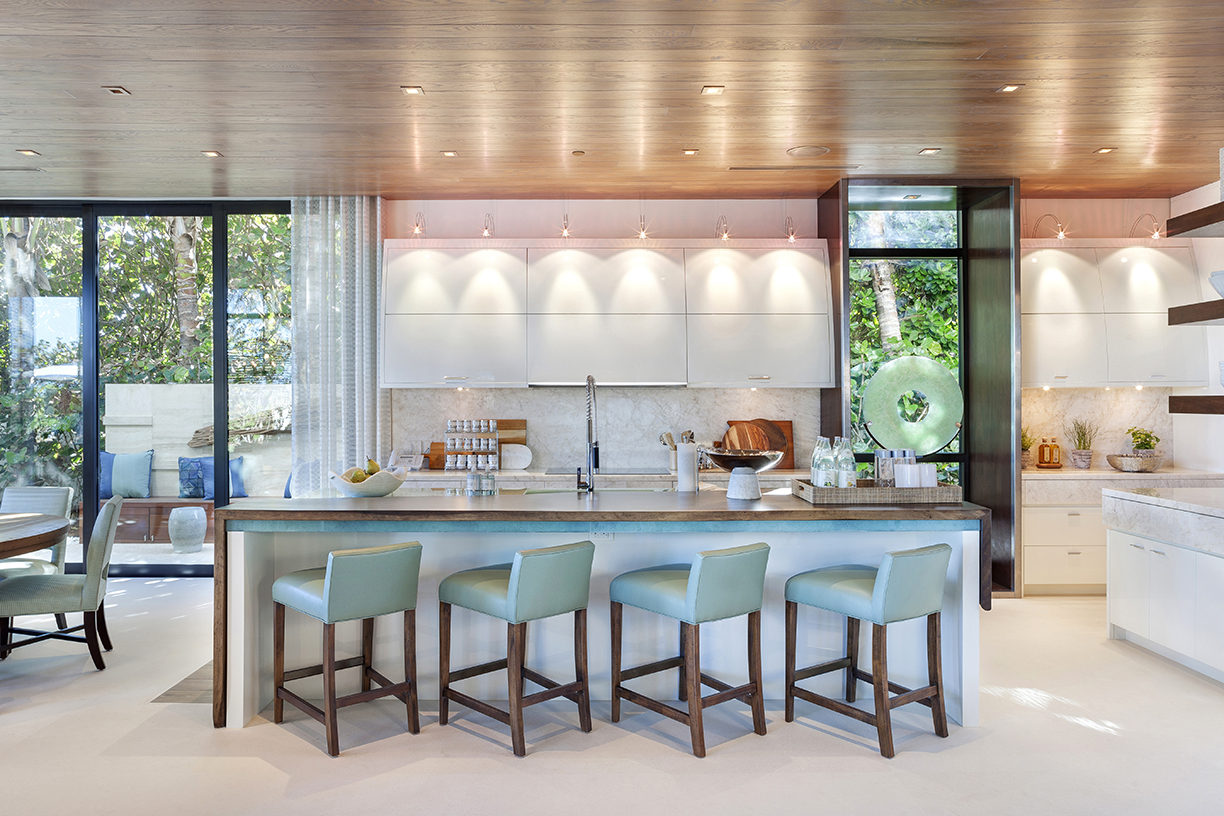
Image courtesy of Marc Thee
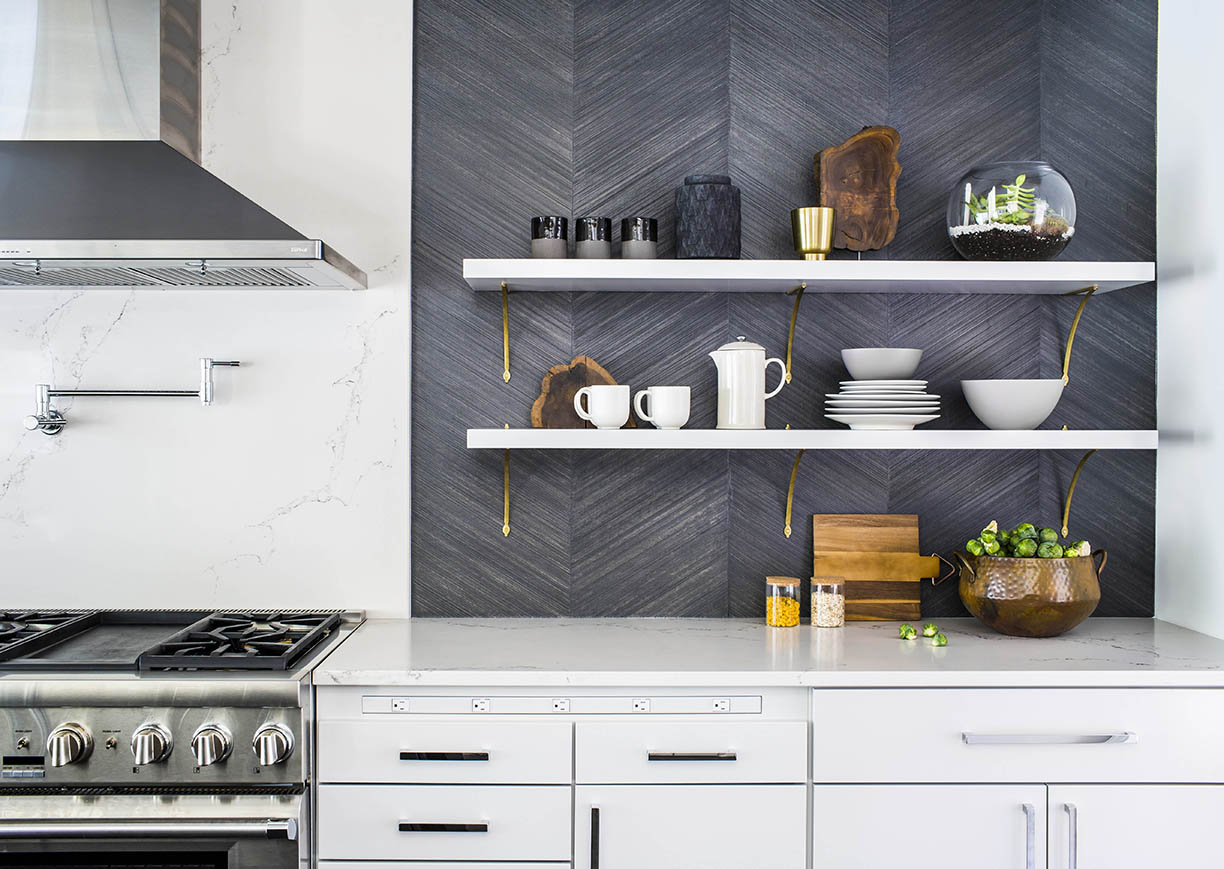
Image courtesy of Ili Hidalgo
“When it comes to marrying groundbreaking innovation and stunning design, Thermador leads the industry — empowering consumers and trade professionals to make bold statements throughout the home,” said Beatriz Sandoval, director of brand marketing for Thermador.
Encouraging the established and flourishing design-build communities to showcase their creativity in any design style, this year’s Kitchen Design Challenge aims to attract the most innovative projects yet, with four all-new categories for submission: Exceptional Kitchen, Compact Kitchen Suite, Original Innovator/Out of the Box Space and the Student Concept Kitchen.
For Exceptional Kitchen, one national winner will receive a $25,000 grand prize, one second-place winner will receive a $15,000 prize, and one third-place winner will receive a $10,000 prize.
In the Compact Kitchen Suite category, the national winner will receive a grand prize of $5,000 for crafting a culinary space within 200 square feet and containing at least three primary Thermador products.

Image courtesy of Constance Riik
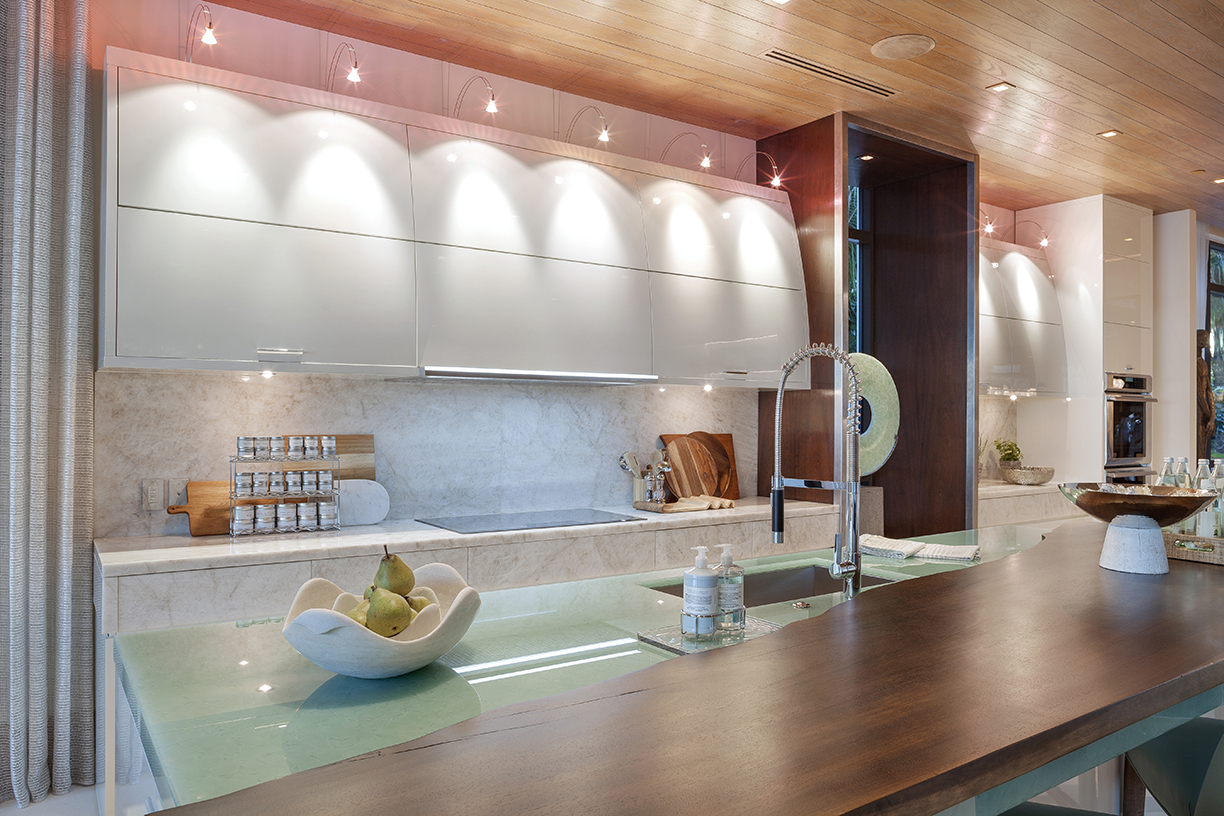
Image courtesy of Marc Thee
The national winner of the Original Innovator/Out of the Box Space will receive a $5,000 prize for designing a space outside of the kitchen such as a wet bar, personal gym, wine cellar or game room. The space must have at least two Thermador products.
And for the first time, the Thermador Kitchen Design challenge is including students in the competition. In the Student Concept Kitchen category, one national winner will receive a $5,000 cash prize for designing an exceptional kitchen for a hypothetical client. The space must be a minimum of 200 square feet, include at least three primary Thermador products and cost a maximum of $250,000.
Two more categories are also part of the challenge, including the Designer’s Choice, which will be chosen at the gala and receive a $5,000 cash prize, and the Fan Favorites category, in which five winners will be selected in a separate contest held in 2021 to receive a $1,000 cash prize each.
By breaking boundaries and the status quo in terms of kitchen design, vision and creativity, Thermador is allowing for others to do the same, creating bold ideas and bringing them to life.
Cocosan Villa, nestled high in the San San Estate in Portland Jamaica, forms part of the Geejam Collection. It offers a uniquely designed take on contemporary Jamaican living. This villa features six bedrooms with balconies overlooking scenes of the beautiful parish of Portland and eight bathrooms.

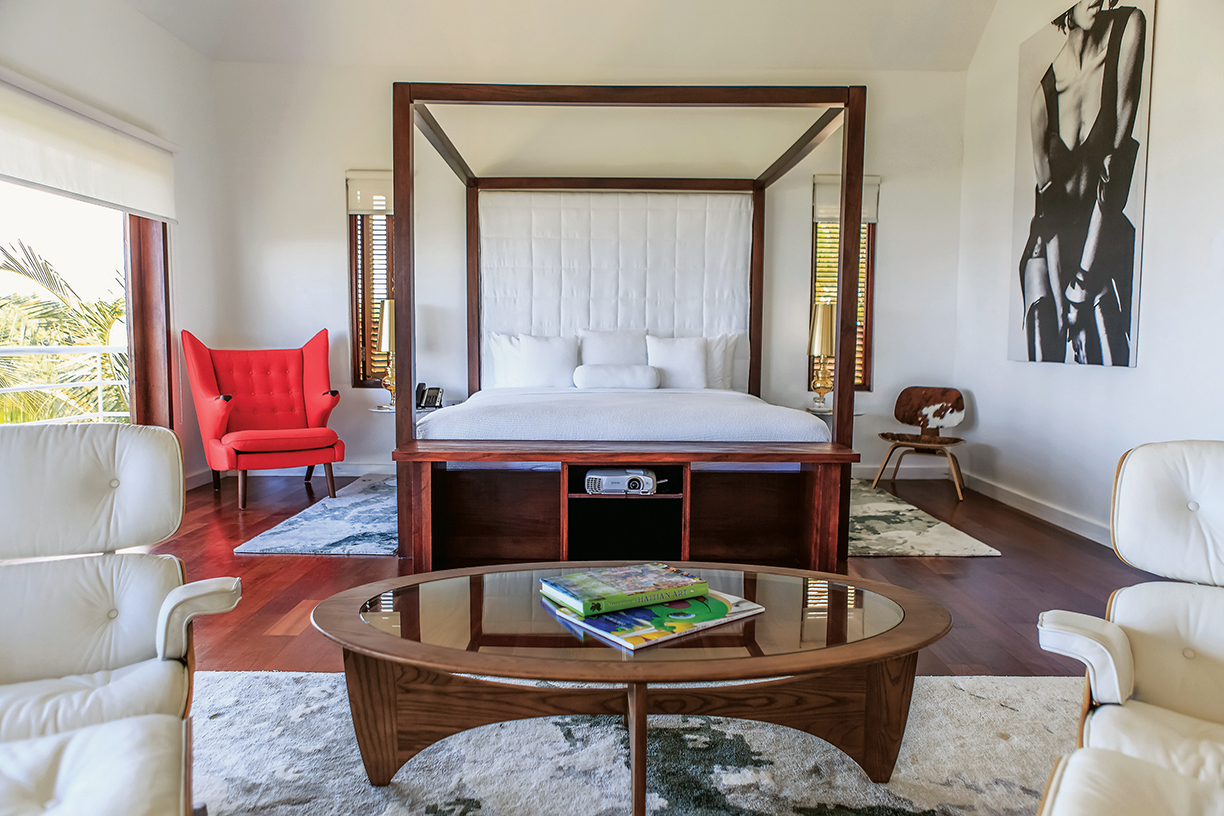
Cocosan’s upscale design is poised with elegance and modern day comfort, while engaging the tropical aesthetic of the Caribbean. The property, listed by Kaili McDonnough Scott of Coldwell Banker Jamaica Realty for $2.9 million, also boasts a gym, sauna, heated lap pool and Jacuzzi, and state-of-the-art kitchen.
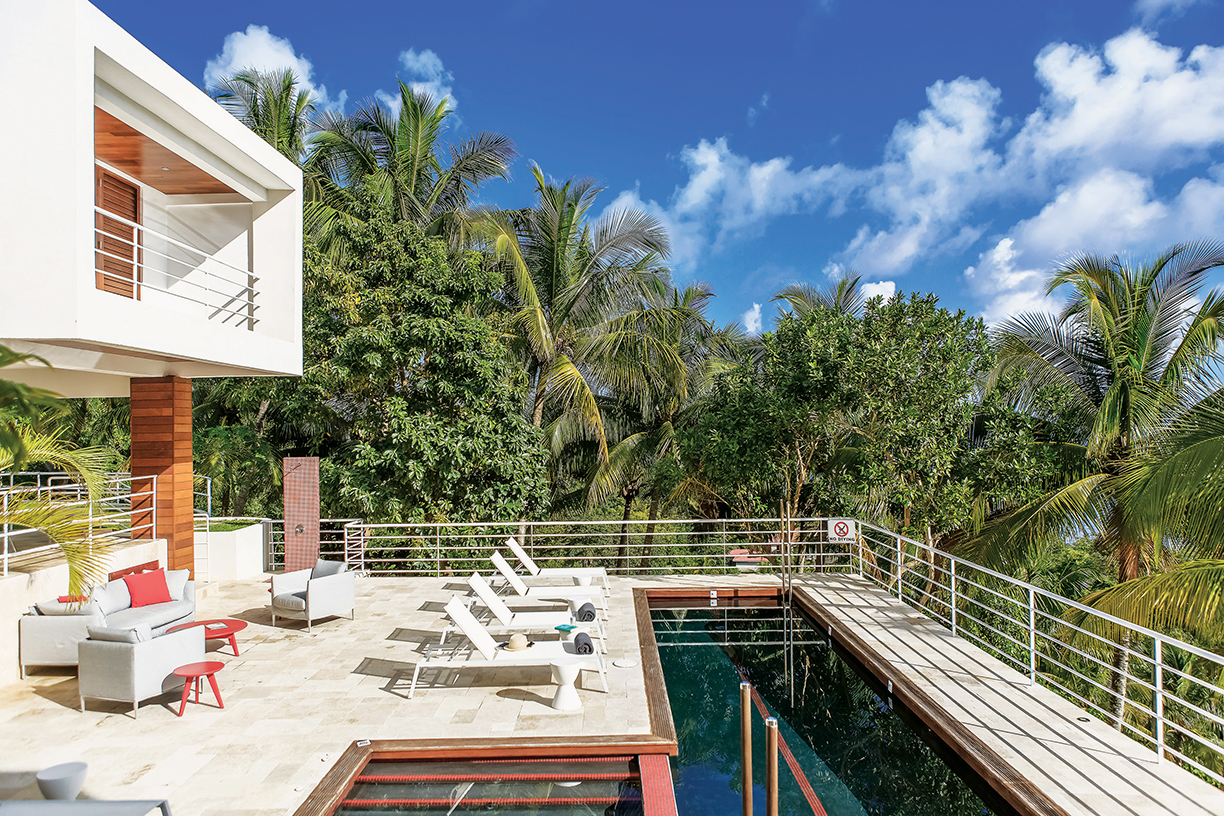
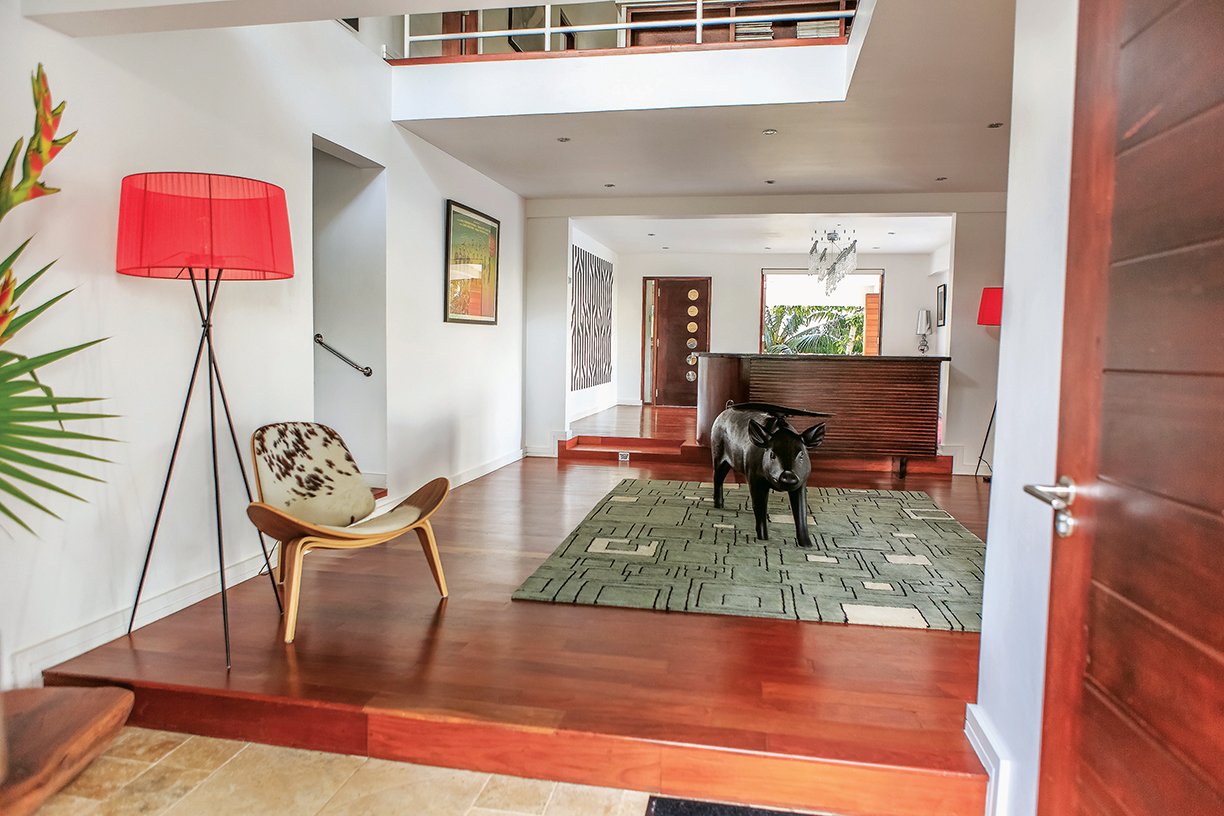
The powder room used to be an afterthought, but for people who entertain this space has become an important design moment. In fact, when it comes to luxury condo buildings, developers are now going above and beyond to create distinct powder rooms that leave a lasting impression – with details like custom wall paneling, unique custom lighting and specially made marble vanities that highlight today’s style trends. To perfect your own powder room, we’ve come up with a few tips based on stylish New York residences.
Embrace the Selfie Lighting
Often small spaces, powder rooms can still offer a great place to capture that perfect Instagram photo, especially if there is good lighting. To create the perfect selfie space, lighting must be on point to not only adequately brighten up the space, as well as both capture the best pose and highlight the style and decor of the room.
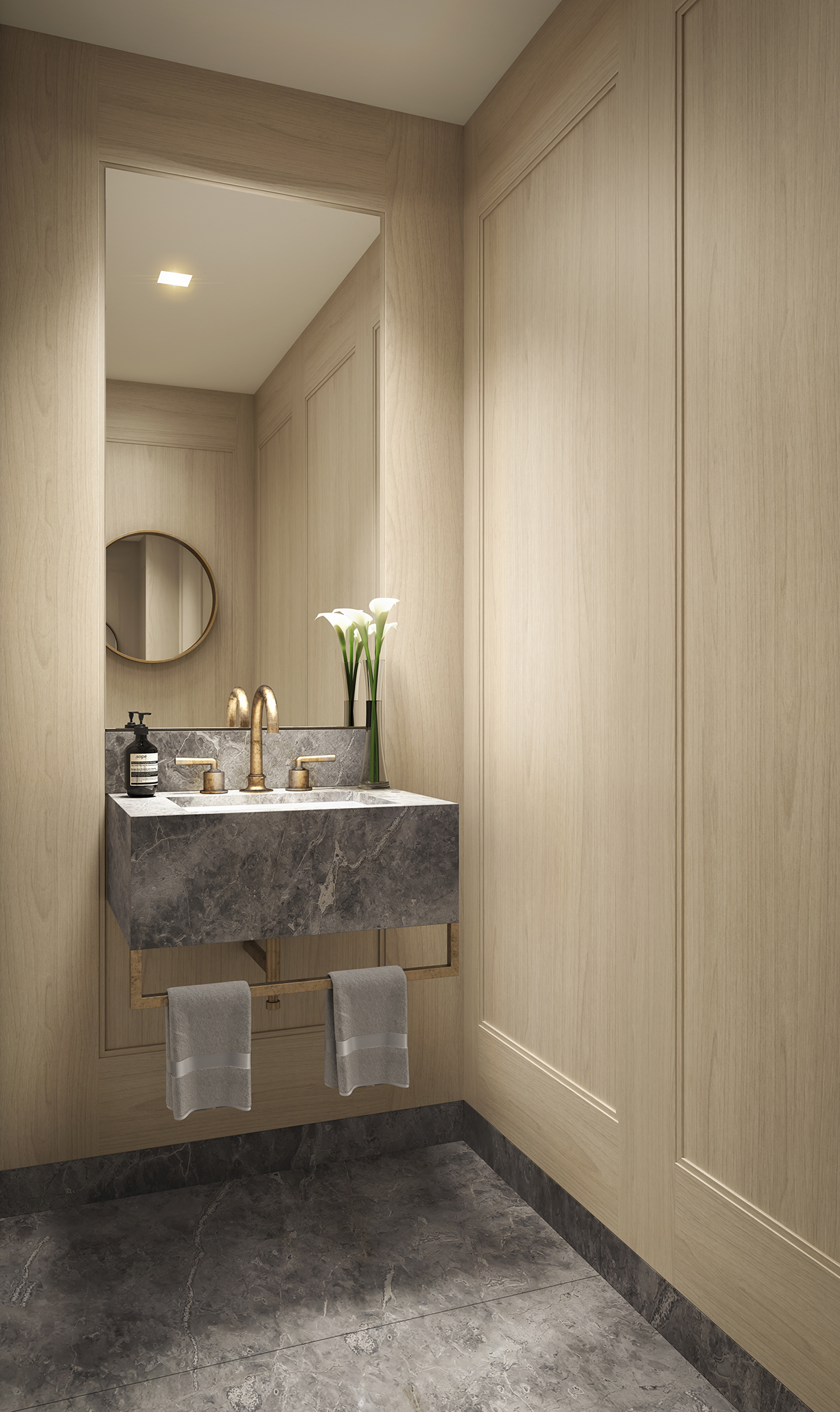
350 West 71st Street
Photo by Alan Hill / Redundant Pixel.
There is some flexibility in this regard. For example, this chic powder room located in one of the residences at 350 West 71st Street offers flawless, bright lighting, making it the perfect spot to apply makeup.
Soft light, however, offers some of the best places to take photos. A great example is seen at 555 West End Avenue, where the mellow glow of the lit mirror highlight the powder room’s luxurious features, from the custom Calacatta gold countertops to the Lefroy Brooks fixtures.
With this lighting choice, you achieve a warm, inviting aesthetic that people will spend trying their best to capture.
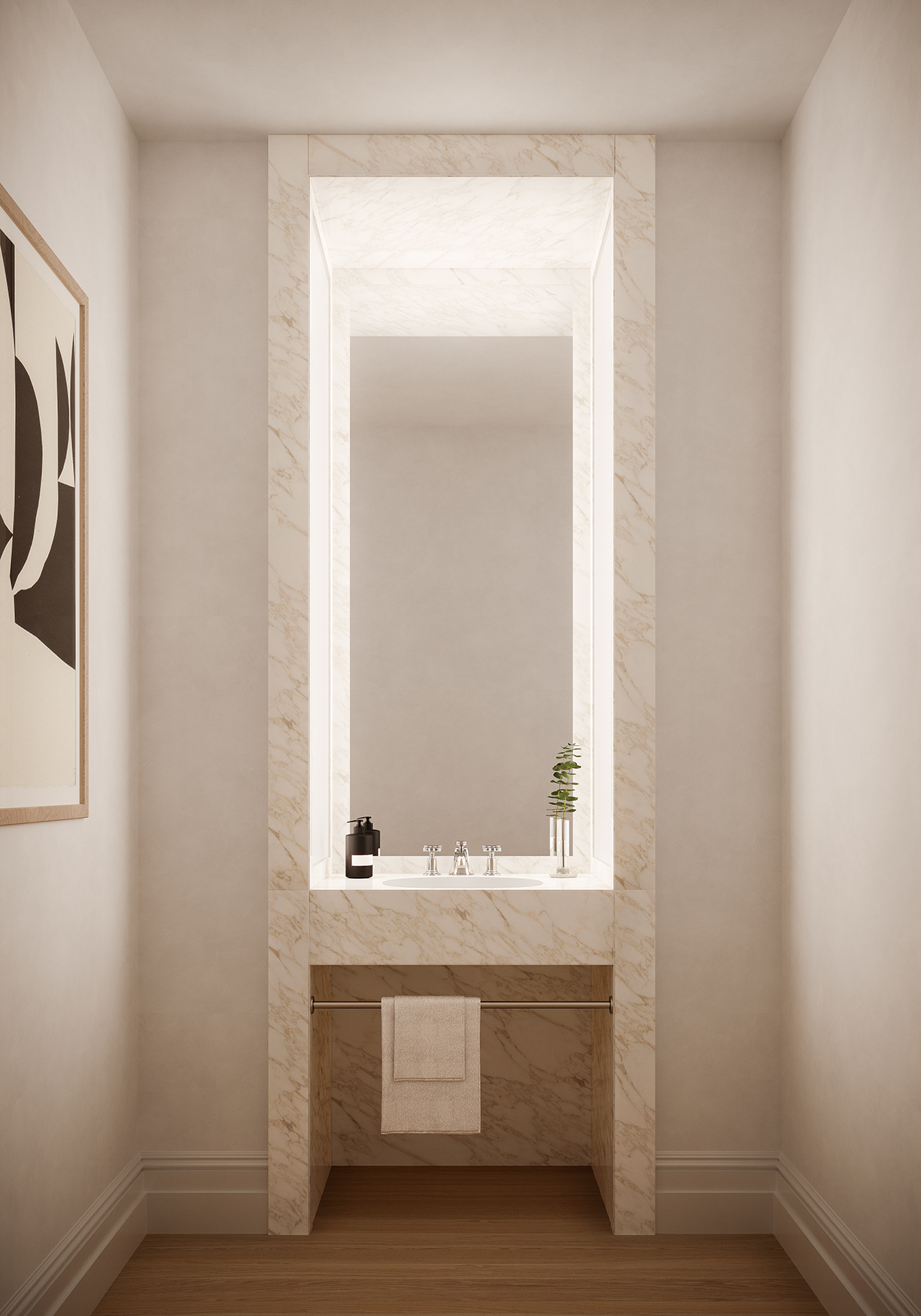
555 West End Avenue
Photo by Hayes Davidson.
Keeping Fashion-Forward
Staying on trend can sometimes be difficult when it comes to home design, so the best way to do so is highlight classic, elegant finishes that remain stylish over time, while incorporating accents and decor that is on trend. Some classic finishes are beautiful marble counters and sinks, black and white tiles or wallpaper, and metallic detailing.
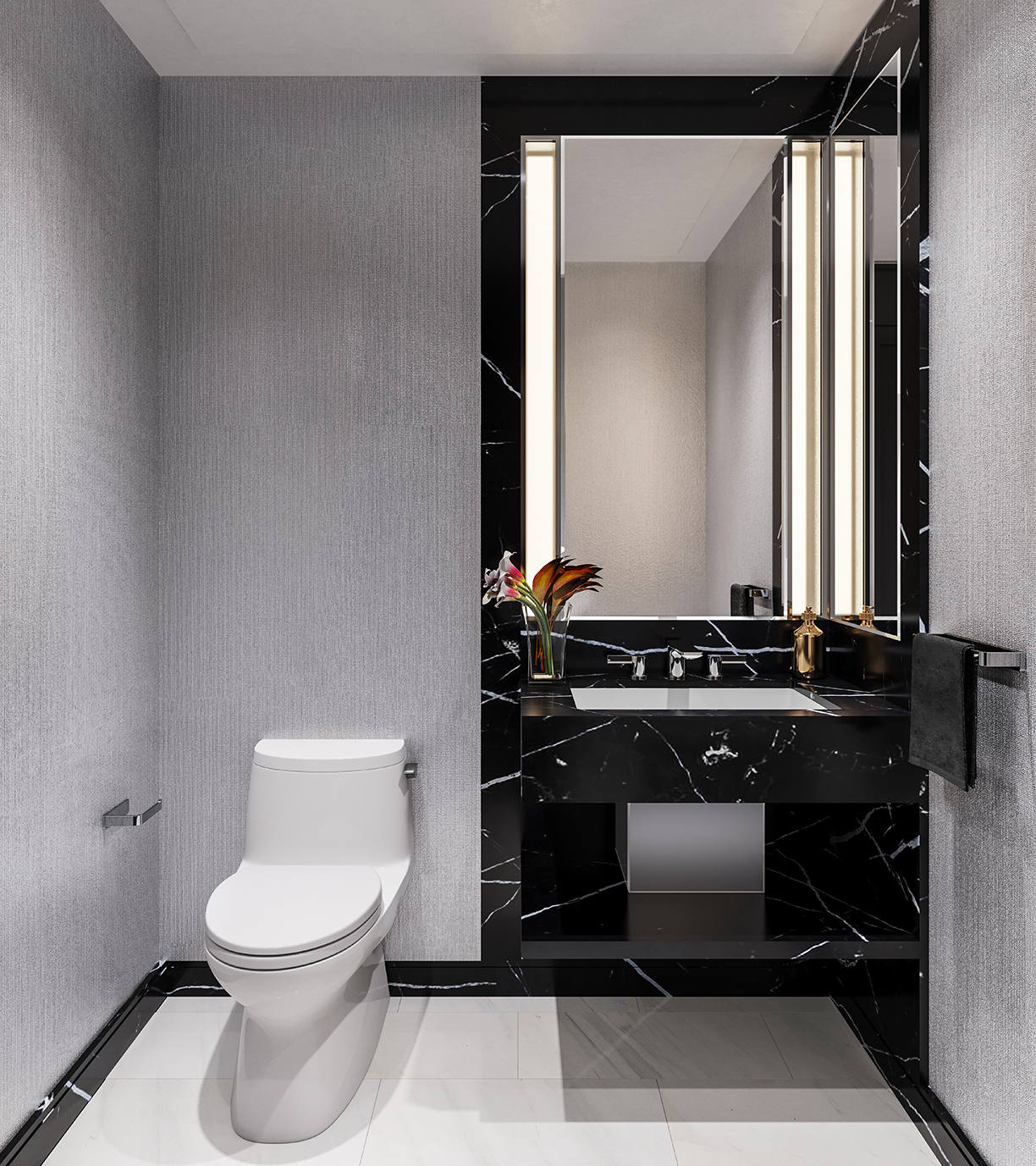
One Waterline Square
Photo by Noe & Associates with The Boundary.
Designed by celebrated architect, Robert A.M. Stern, 30 Park Place offers 157 residences, all managed by Four Seasons Hotels and Resorts.
Within the powder rooms of Penthouse 78B, marble vanities offer a minimalistic yet beautiful setting with its clean lines and silver accents, both elegant and modern.
The Champalimaud-designed powder rooms at One Waterline Square are jewel-box-like spaces fashioned in striking black and white marble.
Every bit as luxurious as the master baths, the sparkling powder rooms feature best-in-class materials and fixtures, including polished Bianco Dolomiti marble flooring, polished Nero Marquina marble vanities and feature walls, Dornbracht fittings, and more.

30 Park Place
Photo by 30 Park Place.
Customization is Key
No matter your style, custom finishes or accents are also a defining decor element that can make or break the style of your powder room. Detailed design elements and customized, select finishes make a strong modern statement, create warmth and elegance in every space. Not only will these be a unique focal point, but inspirational in design for those looking to spruce up their own spaces.
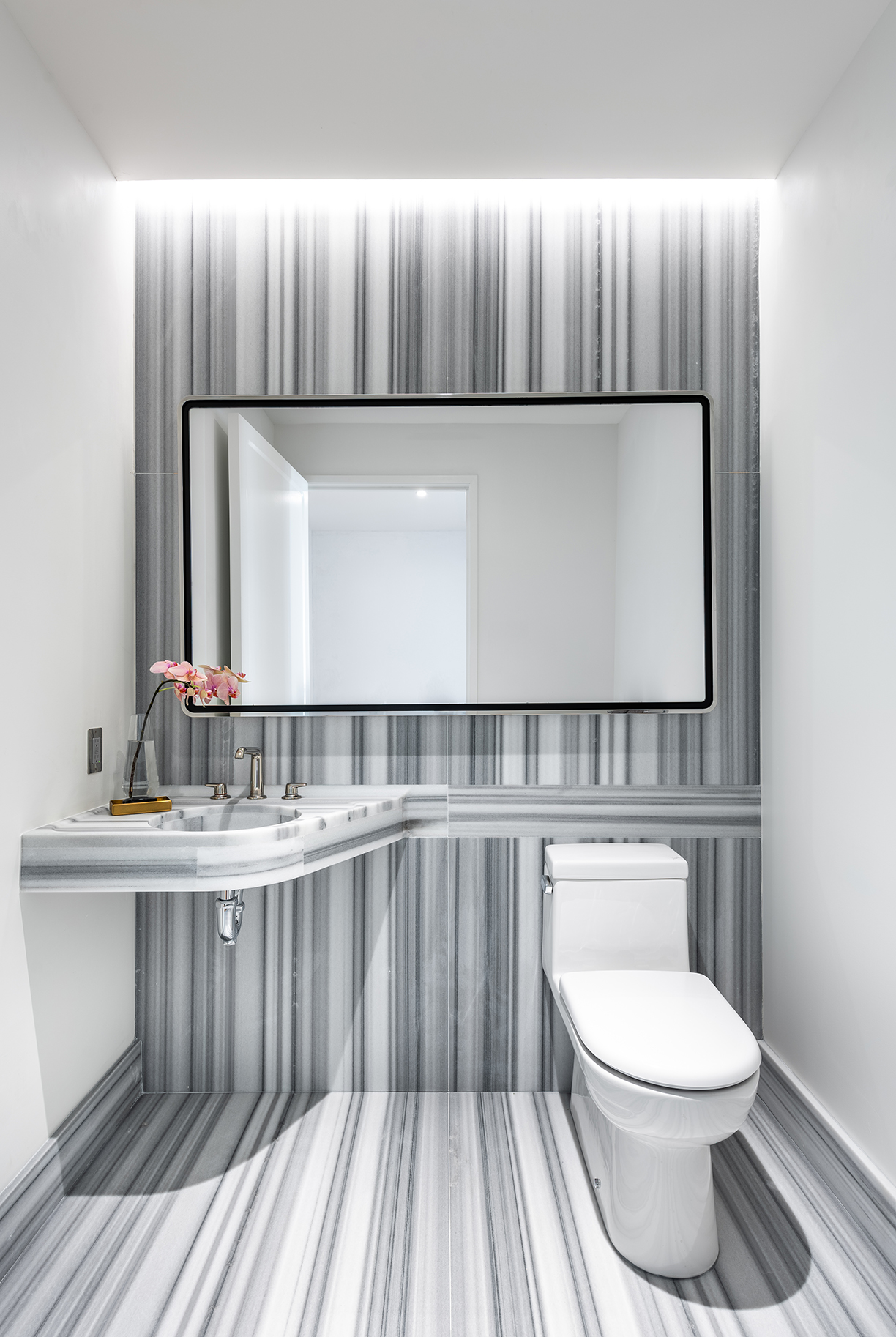
Greenwich West
Photo by Alan Tansey.
Located at 110 Charlton Street, Greenwich West’s interiors have been beautifully designed by star Parisian architect and interior designer Sebastien Segers, who is known for his work with clients such as Giorgio Armani, Christian Dior and more.
A standout within, the powder rooms at Greenwich West are outfitted in Zebrino marble with custom-designed curved vanities featuring Laufen toilets and Hansgrohe Axor Bouroullec collection fittings in polished nickel.
A contrast of black and white, Segers’ signature ogee edge shape makes this a statement room.
Custom designing everything in the 61 light filled residences at 40 Bleecker in NoHo, the powder rooms leave no detail unturned.
Within the powder rooms, hand-selected statuary marble envelops the area and a unique lighting design by Bill Schwinghammer.
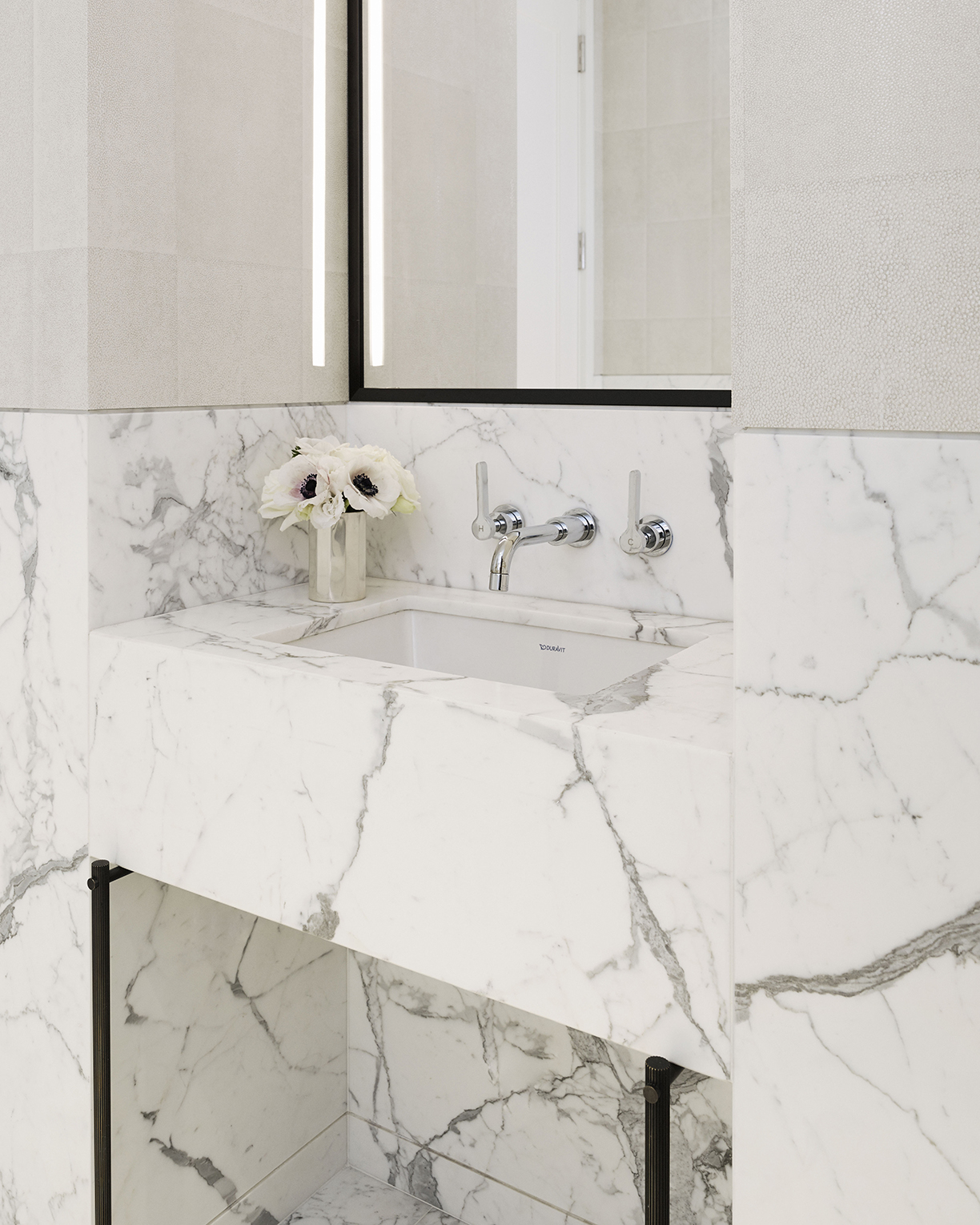
40 Bleeker
Photo by Bjorn Wallender.
Lisa Adams, CEO and lead designer of LA Closet Design, the Los Angeles-based firm that changed the way we look at our closets, is ready to unveil her very own first-ever dream dressing room and closet, and we’d love to offer you a peek inside.
After a decade of conceiving, designing and building fantasy-inspired spaces for celebrities, billionaires and tastemakers around the world, she finally put her experience to work in meshing form and fashion with high functionality in the creation of her own master closet, dressing room and handbag closet.

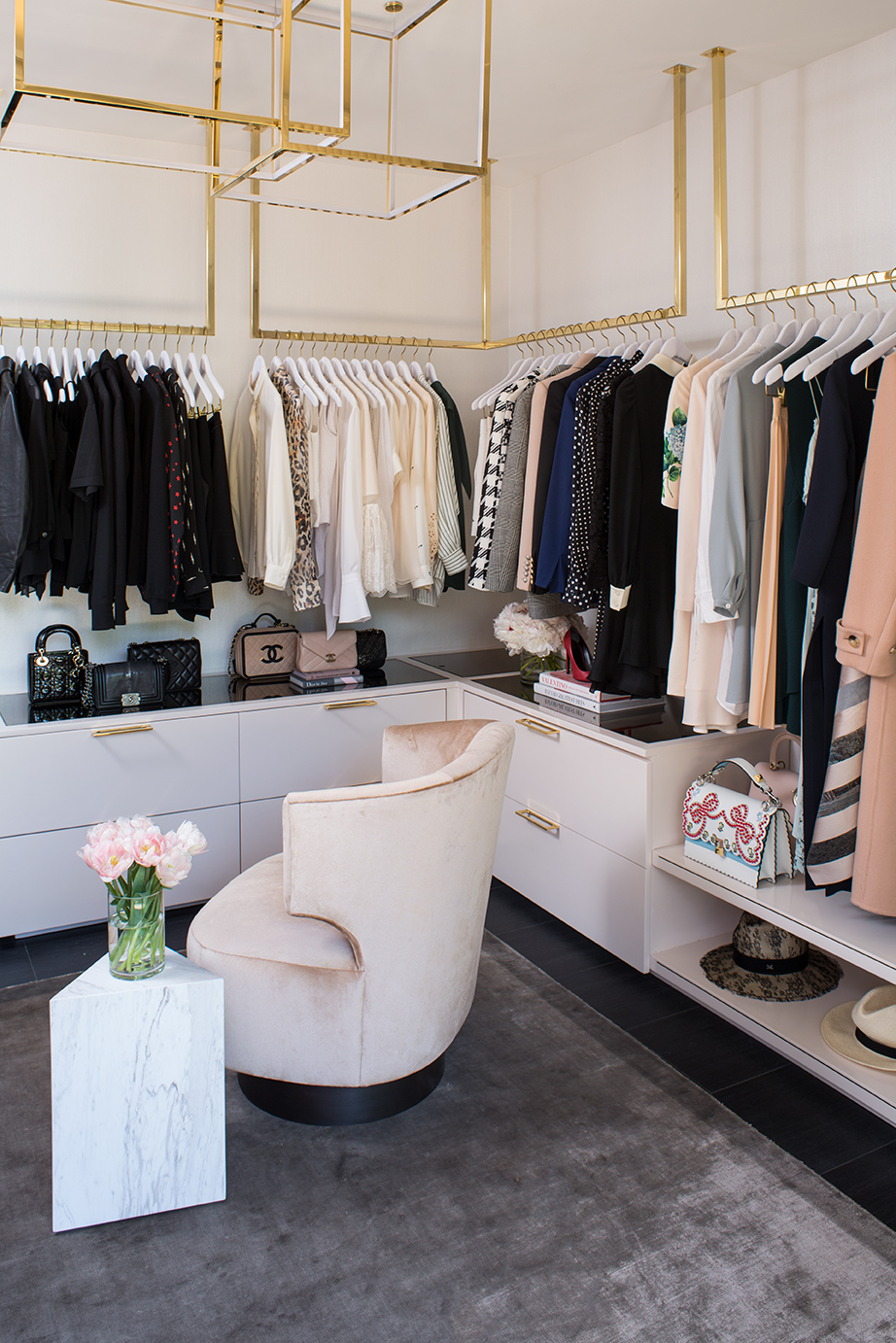
As she does with all her clients, her closet flows seamlessly with her home’s prevailing aesthetic as well as reflects her very own personal style. The result is a chic, elegant and soothing place in which to start her day and house her most precious belongings.
Everything in the closets reflect Lisa’s taste for timeless elegance from the pale palate and soft touches to Hermes ceiling wallpaper, custom Portola paint color created just for Lisa (she even got to name it – Closet Cashmere) and the bold but spare geometric LED brass light fixtures.
As the creative force behind LA Closet Design, Lisa’s vision is to create “personalized dressing spaces to calm the chaos of everyday living.” Her inspiration for maximizing and beautifying closet spaces came about while working for a kitchen design firm.
Seeing the great level of interest both from home owners and investors in making kitchens the new gathering space (and selling point), and a space worthy of living in and showing off, she realized that closets were the next great frontier.
Traditionally seen and used as a space for storage and a place where the door is always closed, Lisa decided to approach the closet as a new living space where homeowners could lounge, prepare, entertain and even “shop” their own closet (a concept she conceived after falling in love with the design of Armani stores).
In her career, she has created spaces for a notable client base, including Christina Aguilera, Reese Witherspoon, Tyra Banks, Khloe Kardashian, Ray Romano and Kris Jenner, among many others.
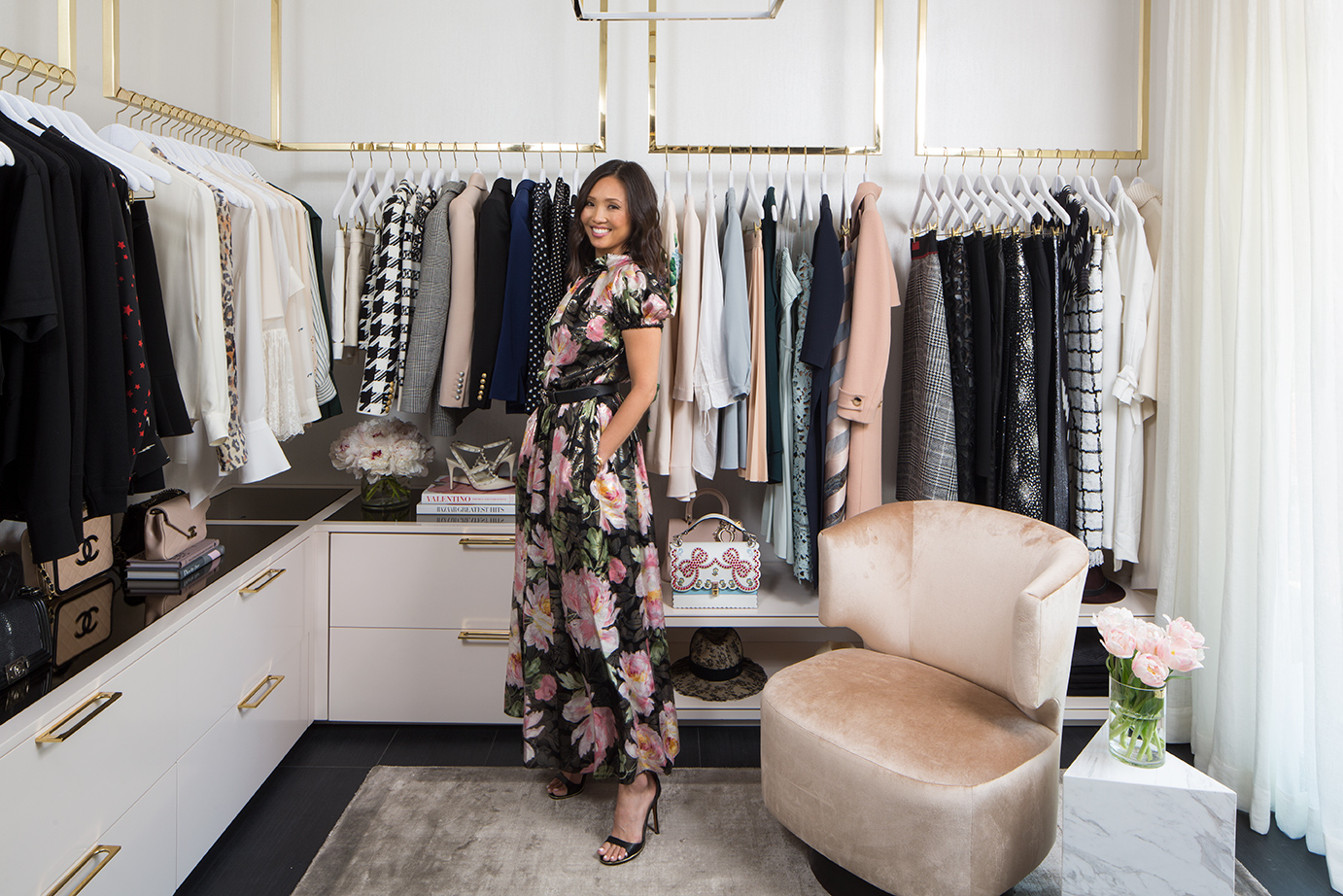
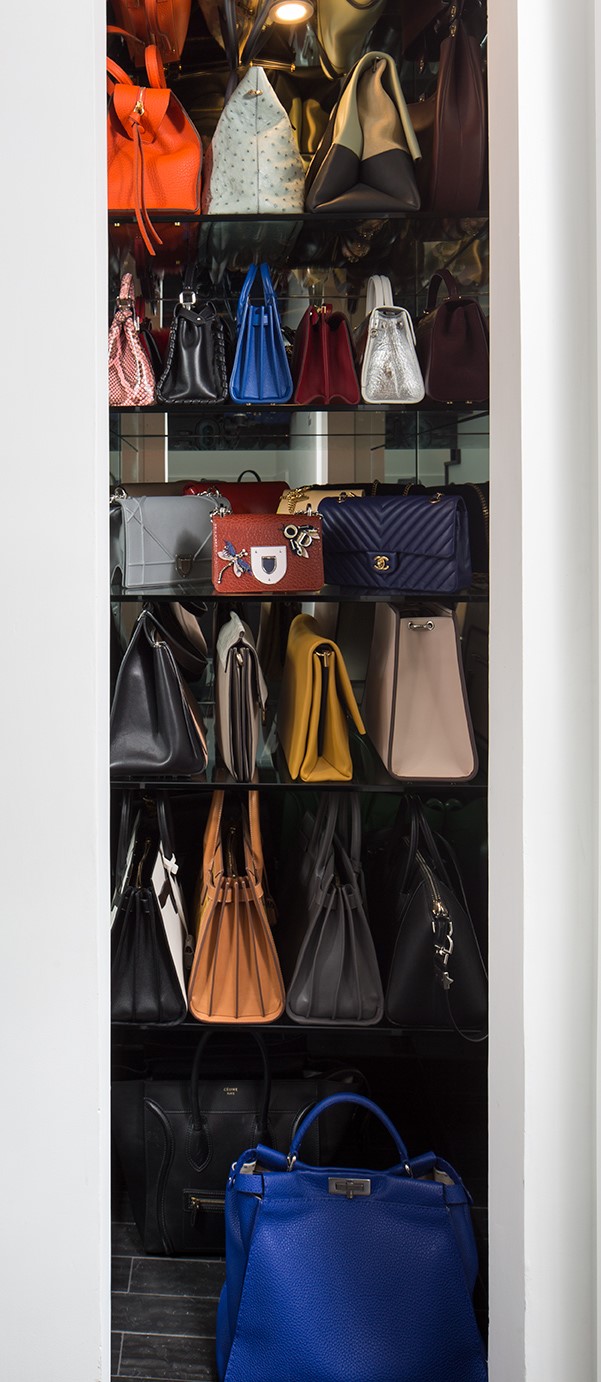
Increasingly, custom aquariums are amenities in demand by luxury homeowners, pushing specialists to create spectacular showcases.
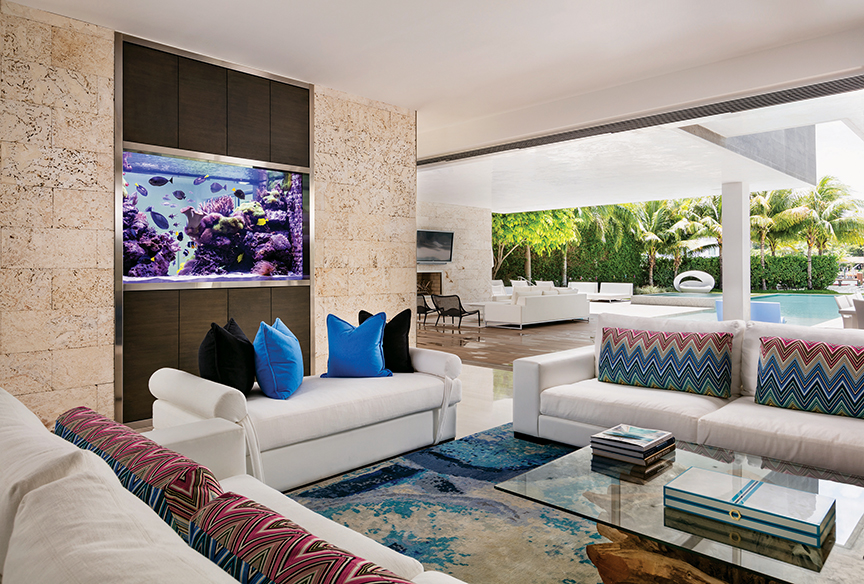
Photo © 2016 Nickolas Sargent All Rights Reserved
Observing decorative tropical fish shimmering through an artificial aquatic habitat can be mesmerizing, but new innovations and elaborate designs have made aquarium industry specialists an essential resource for luxury residential design. A new breed of aquarists is using unbridled imagination and advanced technologies to create larger and more audacious tanks for the home.
Reality television series like Tanked on Animal Planet and Fish Tank Kings on Nat Geo Wild introduce viewers to the incredible possibilities of aquarium design, resulting in focal points that can transform a room into a magical space. High-end aquarists can now be found in every major city and ambitious tanks can be engineered for virtually any residential environment.
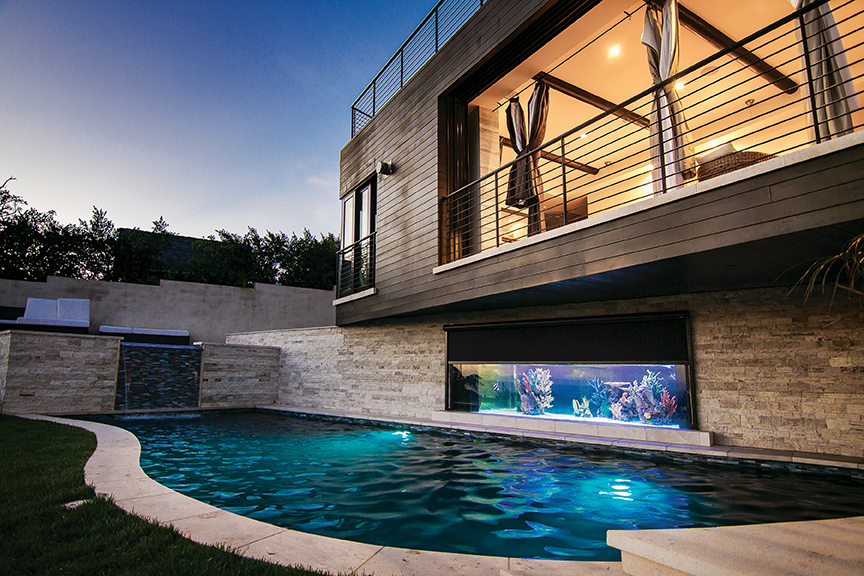
Photo courtesy of Infinity Aquarium Design
Nic Tiemens, co-founder of Los Angeles-based Infinity Aquarium Design, reports, “The installations we’re doing today in high-end residences are more elaborate, both aesthetically and functionally, than those in most public aquariums.” Tiemens’ first taste of the business, as a young minimum-wage employee in Chicago, was the installation of two massive tanks at NBA superstar Michael Jordan’s house. When he and his business partner founded Infinity in 2004, they viewed L.A. as a natural home base, and the firm was featured on HGTV’s Ultimate Aquariums, one of the public’s earliest glimpses into this intriguing specialty. “We’ve branded ourselves as the firm where creativity meets the science of aquariums,” explains the passionate entrepreneur.
Tiemens suggests that homeowners’ increased reliance on interior designers has boosted the residential aquarium business, as those ambitious professionals are constantly looking to enhance spaces with unique water features. Celebrity-favored L.A. interior designer Adam Hunter, who collaborates with Infinity in his luxury residential practice, reports, “Aquariums offer such dramatic appeal to any interior because they can instantly become a beautiful focal point, art piece or topic of conversation.”
Hunter believes aquariums work equally well in both traditional and modern architectural contexts, and the endless options of aquatic environments and species allow designers and aquarists to accommodate virtually any situation. “When you spend hundreds of hours paying attention to every last detail that makes an interior perfect, having an organic, living backdrop provides the ideal contrast to such a structured and scrutinized design,” he explains.
Double-sided tanks are popular and at a Hawaiian-inspired Malibu retreat, Infinity completed a stunning indoor-outdoor poolside aquarium. “From the basement, you can look through the aquarium into the swimming pool, beyond the bluff and out into the ocean,” Tiemens explains of the $80,000 project.
Although nearly 90 percent of the company’s projects are saltwater tanks, Tiemens has observed a sharp uptick in requests for live plant freshwater aquariums as clients become more conscious of sustainability. The company recently completed the largest freshwater planted aquarium in a private U.S. residence for a homeowner aspiring to recreate the work of renowned Japanese aquarist and photographer Takashi Amano.
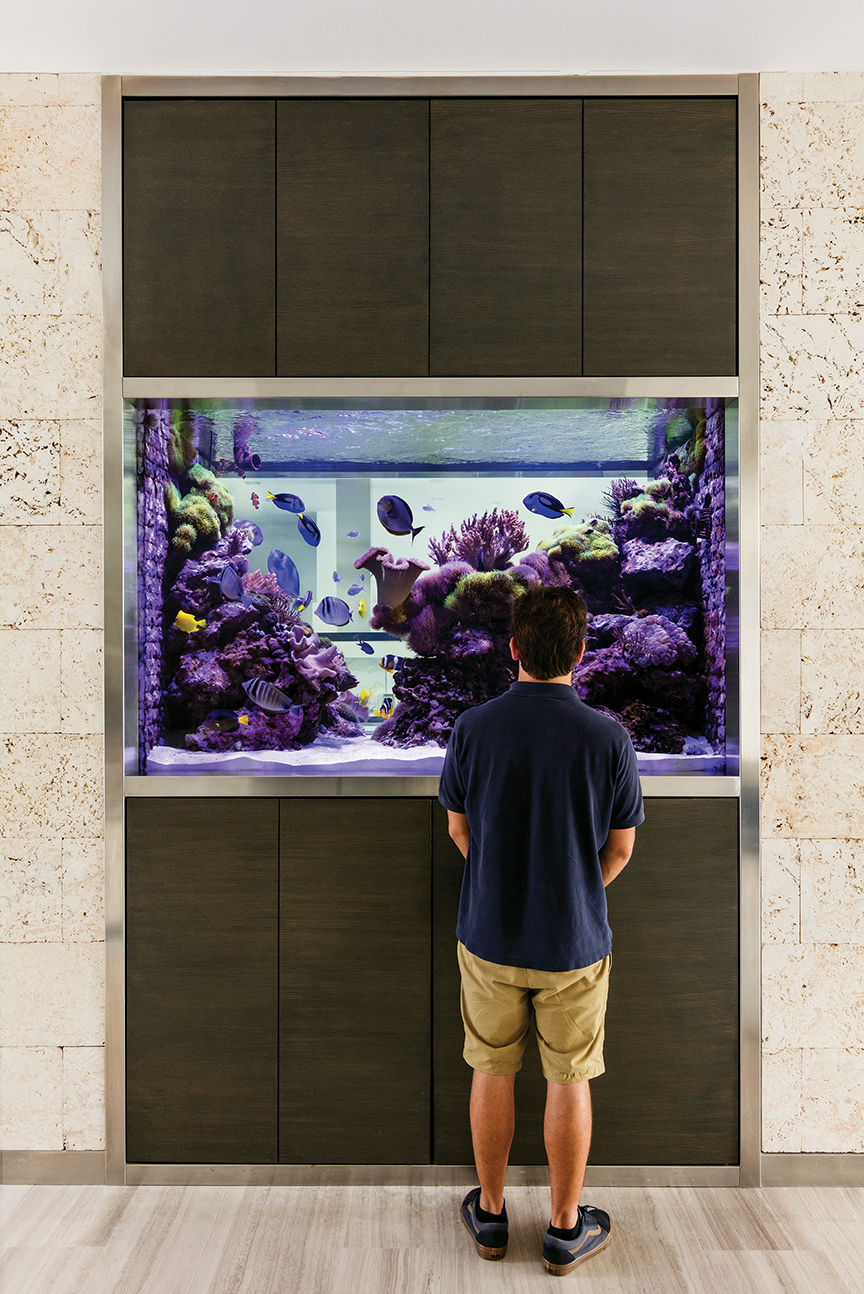
Photo © 2016 Nickolas Sargent All Rights Reserved
Reef Aquaria Design (RAD), located in South Florida, also caters to a demanding luxury residential clientele. Operations Manager J.R. Corvison agrees that public aquariums and a heightened environmental consciousness of the oceans have fueled interest, and states some of RAD’s high-end installations cost more than most people pay for a home. “Those with the means have the ability to commission a piece of dynamic living art showcasing the ocean’s splendor right in their own home,” says Corvison. He reports client enthusiasm for jellyfish aquariums, especially in homes with sleek, modern architecture, as well as burgeoning interest in the aquaculture of fish and live corals.
The stars of Tanked, brothers-in-law Brett Raymer and Wayde King, are the owners of Las Vegas-based Acrylic Tank Manufacturing (ATM). Since their show debuted in 2011, the pair has created over-the-top aquariums for actors Neil Patrick Harris and David Hasselhoff, magicians Penn & Teller, and professional athletes Marshawn Lynch, Dwayne Wade and Shaquille O’Neill.
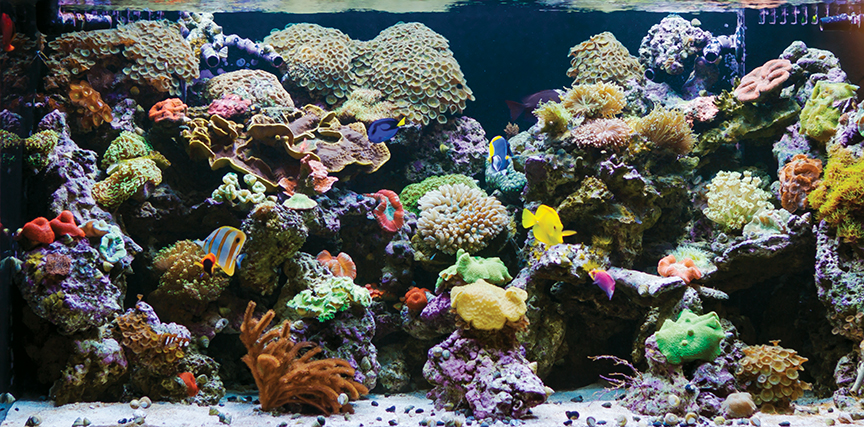
Photo courtesy of Infinity Aquarium Design.
“The popularity of public aquariums has grown over the years, giving people more opportunities to see exotic species, and everybody’s intrigued by fish,” says Raymer, who suggests the ability to maintain live corals and reefs accounts for the popularity of saltwater tanks. “The tanks are educational, soothing and relaxing to look at,” says the enthusiastic King of the hobby’s universal allure, adding, “The colors of fish are incredibly appealing and they all have their own personalities.”
Raymer reports that while it may scratch easier than glass, acrylic has become the state-of-the-art material for extravagant designs because of its ability to be bent and shaped. ATM’s design and installation process begins with an interview of the customer, whether a celebrity or suburban hobbyist. “First we find out what the client has in mind, then turn it over to our artist to create a rendering. Once we get the client’s approval, we go from there,” explains Raymer.
One of the company’s more outrageous projects, scheduled to appear on Tanked later this year, features the third appearance of comedian Tracy Morgan, whose pool house in posh Alpine, New Jersey, will be transformed into a massive 16,000-gallon shark tank designed by ATM. King explains sufficient space, structural soundness and a willingness to take care of the habitat (in addition to capital, of course) are the only limitations to ever-more-elaborate aquariums. ATM’s largest project was a $4.5 million aquarium for a megachurch in Texas, and an upcoming 70,000-gallon project in California will be the largest tank ever installed in a private residence.
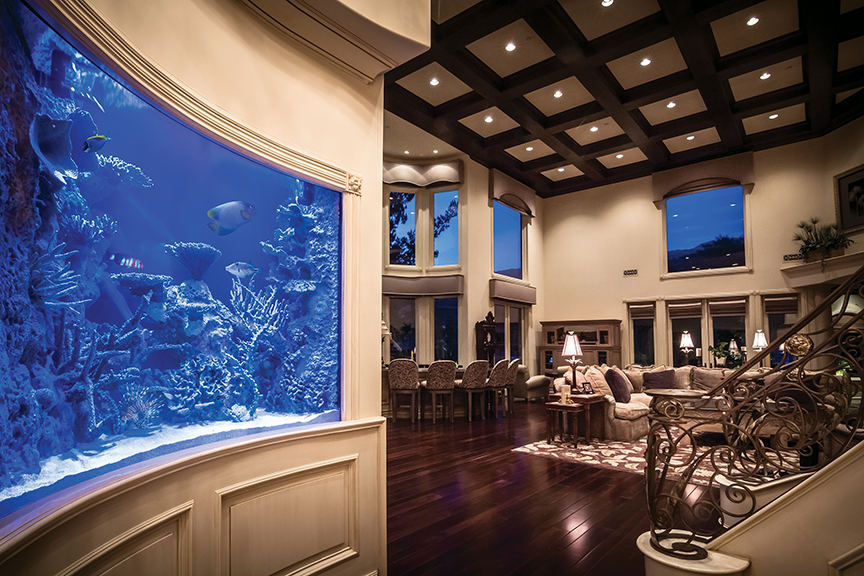
Photos courtesy of Infinity Aquarium Design.
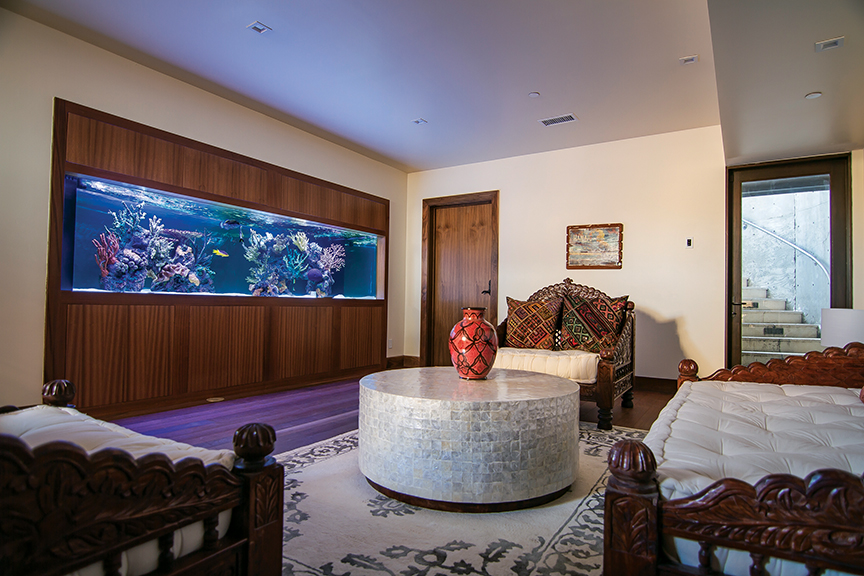
Jay Silber, a partner at Lakewood, New Jersey’s Aqua Creations — which serves metro New York City and beyond — reports affluent clients love the soothing effects of aquariums, while other owners are attracted to the feng shui benefits of having water and fish in a home. “One very wealthy client, he’s a big player whose home has a media room, disco room and everything you could ask for, tells me, ‘Jay, when I entertain, the first place everybody goes is to the tank!’”
Silber reports, “We build aquariums from $20,000 to $100,000, depending on how crazy you want to go, but we concentrate on creating a really interesting environment.” He insists the best installation practice is from the ground up, working with architects and builders to engineer the tank, accommodate proper plumbing and allocate sufficient space for an equipment room.
Compatibility, color and movement are the critical considerations when selecting the assortment of fish, according to Tiemens. “We try to create an underwater display that’s realistic and offers an environment that’s natural for the respective species, one in which every color of the rainbow is presented and where you’re constantly seeing different fish,” he says.
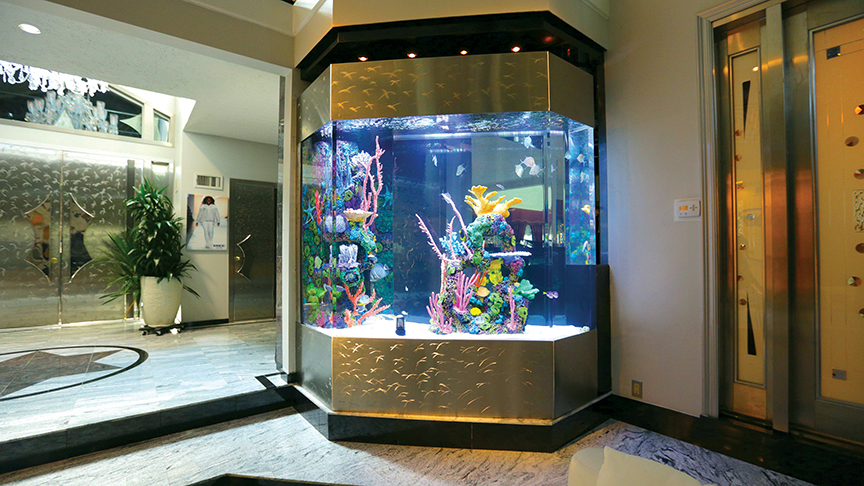
Photo courtesy of Life Aquariums.
Brett Raymer of ATM cautions homeowners, “You need to remember these are live animals … they’re pets, not just decoration, so you can’t just get it set up and forget about it.” He therefore advises clients to enter into a maintenance contract with a reputable company like ATM to ensure proper care. These days, advanced technology allows owners or aquarists to monitor water quality and manipulate pumps from anywhere in the world with the touch of a smartphone.
Acrylic Tank Manufacturing Las Vegas www.acrylicaquariums.com
Aqua Creations Lakewood, NJ www.aquacustomfishtanks.com
Reef Aquaria Design Coconut Creek, FL www.reefaquariadesign.com
Adam Hunter, Inc. Los Angeles www.adamhunterinc.com
Infinity Aquarium Design Los Angeles www.infinityaquariums.com
Offering a one-stop shop for high-end design — architecture, landscape architecture and interior design services under a single roof on Los Angeles’ famed Miracle Mile — is Studio William Hefner.
The office’s location on this stretch of Wilshire Boulevard, lined by Art Deco masterpieces and many of the city’s museums, is clearly inspirational for designers.
Originally from Northern California, Hefner arrived in Los Angeles to earn a graduate degree in architecture from UCLA and founded his current practice in 1989. He oversees a highly collaborative staff of about 35 in L.A. and maintains a smaller office in the idyllic coastal community of Montecito, outside of Santa Barbara.
Hefner, who studied art history in college and appreciates a diversity of design, draws inspiration from landmark residences scattered throughout Southern California. He is appreciative of traditionalists like Wallace Neff and Paul Williams — their Mediterranean estates have long been popular with Hollywood celebrities — as well as Mid-Century Modern masters Rudolph Schindler and Richard Neutra. As a result, Hefner’s practice encompasses a wide spectrum of architectural styles and his firm adapts to evolving preferences.
“In my practice, I try not to have a ‘signature’ style but strive toward quality design and execution in different genres, from very traditional to contemporary,” says Hefner, who reports about 60 percent of his current commissions are modern, a share that has doubled in the past decade. “Modern residential architecture has come in and out of style over the past 30 years but is finally becoming more of a lifestyle, not just a fashion or trend,” says Hefner, who adds, “I think it’s here to stay.” In Los Angeles — where so many high-end homes are in the hills or along the coast — modern design maximizes views and suits the region’s indoor-outdoor lifestyle.
Commissioned to design a massive residence on 10 precious acres in L.A.’s opulent Bel-Air neighborhood, Hefner created a formidable French-style estate known as Château des Fleurs. The client’s original inspiration was the majestic Hôtel du Cap on France’s Côte d’Azur, and Hefner conducted extensive research in Paris, Versailles and the Loire Valley to ensure that every detail was authentic. “We wanted to make sure each room was special and unique,” explains Hefner of the house, which has 31 bathrooms. Despite the scale of the project, the architect took care to create intimate, family-friendly spaces throughout the home in addition to grand rooms for entertainment.
When the 60,000-square-foot residence was completed in 2013 after five years of construction, it was the largest home in a city famous for conspicuous consumption. In his lavishly illustrated book Château des Fleurs (Pointed Leaf Press, 2016), Hefner explains a progressive approach to classic French design. “The balance of this house was to create a powerfully simple structure that would feel timeless and not imitative, while inviting an Old World opulence to the fit and finish of the architecture in a way that would be both decorative and something more: modern,” he writes.

Another more classically inspired design from Hefner is an oceanfront home in L.A.’s Pacific Palisades, a celebrity-favored enclave with a rich architectural history. This home features an Italianate design, dazzling spiral staircase and lush landscaping. In the very same community, in the foothills of the Santa Monica Mountains, Hefner authored a sprawling modern residence in which the floorplan was meticulously oriented to ensure optimal views from every room.
An approximately 7,000-square-foot home in Beverly Hills’ coveted Trousdale Estates is one of Studio William Hefner’s most notable expressions of modernism. Reminiscent of L.A.’s influential Case Study Houses from prominent Mid-Century Modern architects, it was commissioned for a client with an extraordinary modern art collection. “Accommodating art is always a challenge in a view house,” says Hefner, who notes the requisite expanses of glass tend to limit available wall space.
In suburban Sierra Madre, a considerably more rustic community than Beverly Hills, Hefner created a thoroughly contemporary residence in an environment where Craftsman bungalows and Spanish Revival homes are the prevailing architecture. But through a generous use of stone and wood, he was able to infuse the property with considerable warmth, softening the impact of its modernist theme.
“My philosophy, in both traditional and modern homes, is to introduce spaces for indoor-outdoor living, which is a reason we offer landscape architecture among our services,” says Hefner. “In Southern California, the entire site becomes a living space, with large patios, covered outdoor living areas and landscaped courtyards that people can use throughout the year,” he explains. In Hefner-designed landscape design projects, swimming pools often double as reflecting pools, fountain-laden patios assume the serenity of Zen gardens and cacti provide a compelling complement to austere clean-lined structures.

Like New York’s idiosyncratic Peter Marino, a talent he admires, Hefner is an architect who has expanded his practice to incorporate interior design. “I always had a strong interest in interiors and was disappointed when some of my early projects were not finished the way I had envisioned them, so I began designing interiors myself,” recounts Hefner. Now heading up the interior specialty at the firm is his wife, accomplished designer Kazuko Hoshino, and the firm produces custom-made furniture and accessories that enhance the interiors she creates.
Among Studio William Hefner’s custom-made products are the Infinity console, a plane of wood supported by two circular bands of steel, and the strikingly contemporary Halo mirror with its echoes of Mid-Century Modernism. Featuring a modern simplicity are the Capri lounge chair and distinctive Willow nightstand. Even the most contemporary of these pieces can complement vintage architectural settings, as Hefner and Hoshino have demonstrated in their own 1920s residence in L.A.’s fashionable Hancock Park neighborhood.

Before Hefner founded his own company, he worked for Skidmore Owings & Merrill, one of the world’s largest and most influential architecture firms, designing high-rise commercial buildings. “It was difficult to establish a personal connection with the ultimate users of the spaces,” laments Hefner, who appreciates residential design because of the more intimate relationship it forges between architect and client. Hefner encourages clients to fully participate in the design process, stating, “I think we do a better job when they’re more involved.”
The firm’s projects continue to be concentrated in Southern California, where Hefner believes the Mediterranean climate and the indoor-outdoor lifestyle it encourages affords him a genuine freedom of creativity. However, Studio William Hefner has designed residences in countries as disparate as South Korea, Turkey and Israel, and is currently undertaking projects in Seattle, the San Francisco Bay Area and Jackson Hole, Wyoming.
Photos courtesy of Laura Hull, James Ray Spahn, and Tyler William Parker

A practical option for the home, the intricate detail and design of rugs are often overlooked by the average customer. To make an informed rug purchase and to know exactly where your money is going, it is important to note that there is much more to buying a rug than just picking one out that matches your couch.
Between knotted, tufted or flat-woven, rug options could seem endless and daunting for a buyer to understand. But, each of the many rug types available on the market serve different purposes, and getting to know them can help buyers make the right choice for their home. Doris Leslie Blau rug gallery breaks down what to know about the five most popular rug constructions, along with their most advantageous use.
Hand-Knotted Rugs
Hand-knotted rugs are considered classics. They are made of colored yarns that are painstakingly tied onto individual warp threads, then secured by one or more rows of weft, a process that requires a great amount of skill and patience. The knotting of a large rug could involve as many as a dozen artisans working simultaneously for months, even years. The result is a sturdy, dense structure that can withstand years without wearing out.
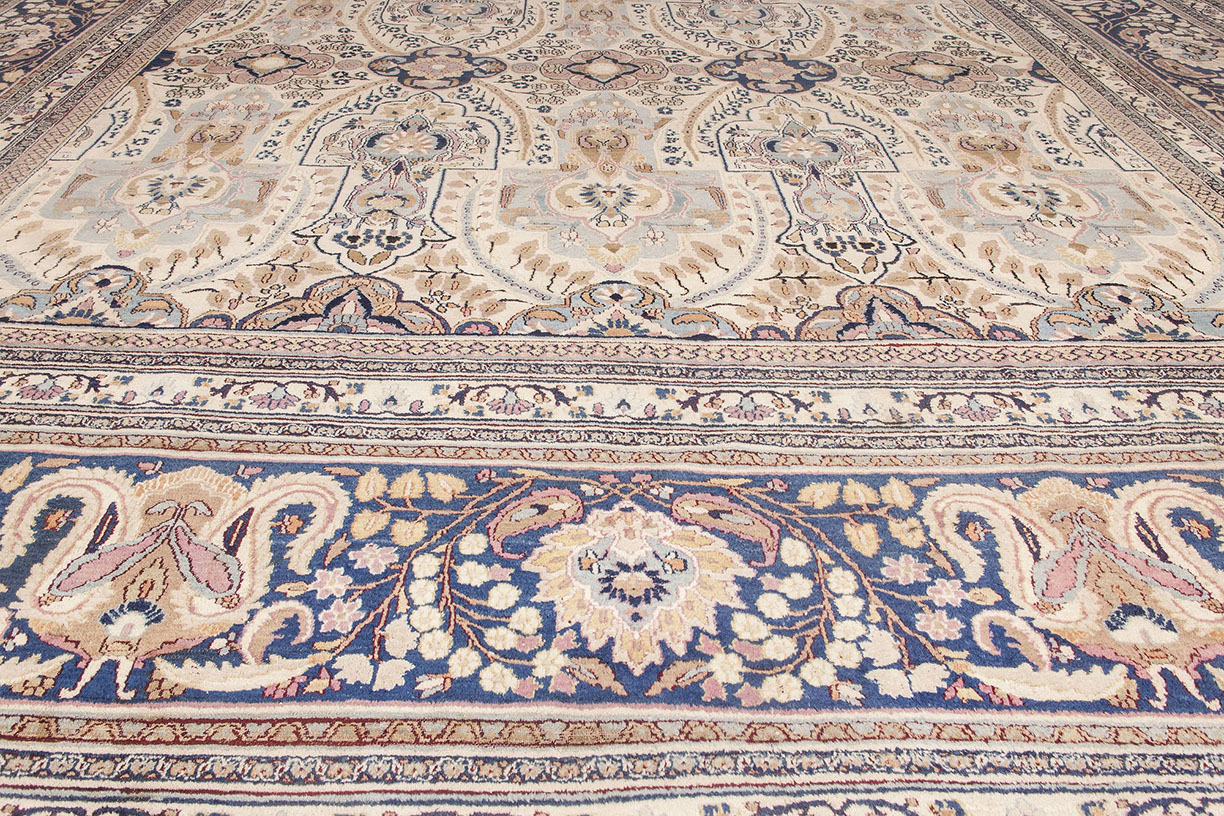
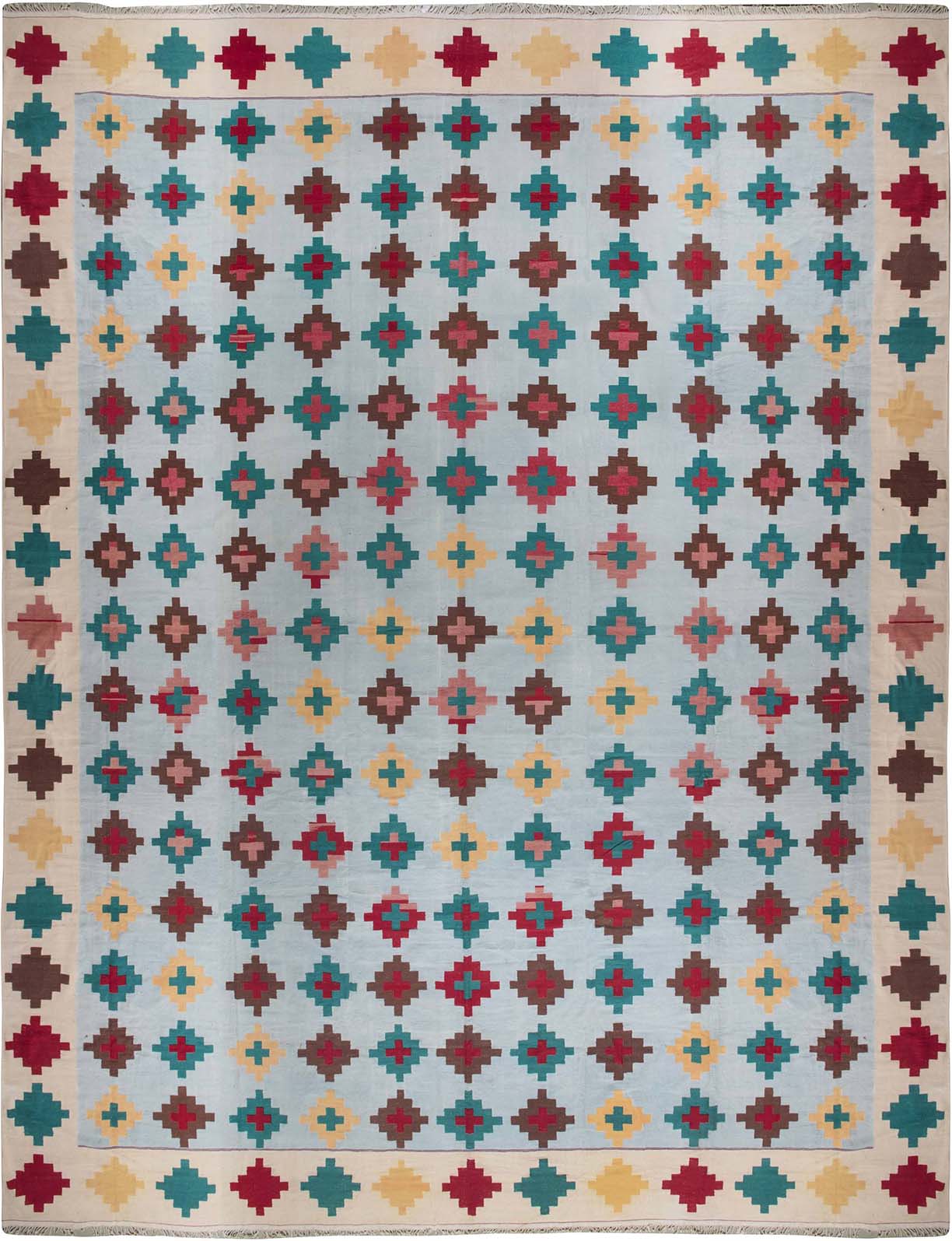
Flat-Woven Rugs
Basic and attractive, these rugs are popular across the globe. The maintenance is low and the rug itself is light and flexible, yet durable. Most are made to be reviserbale, which extends its lifespan even further.
Hand-Tufted Rugs
A more affordable option than knotted carpets, this rug is a great pick for mid-range durability and style. The designs of the rugs can be easily manipulated, from traditional to contemporary, with much textural detail.
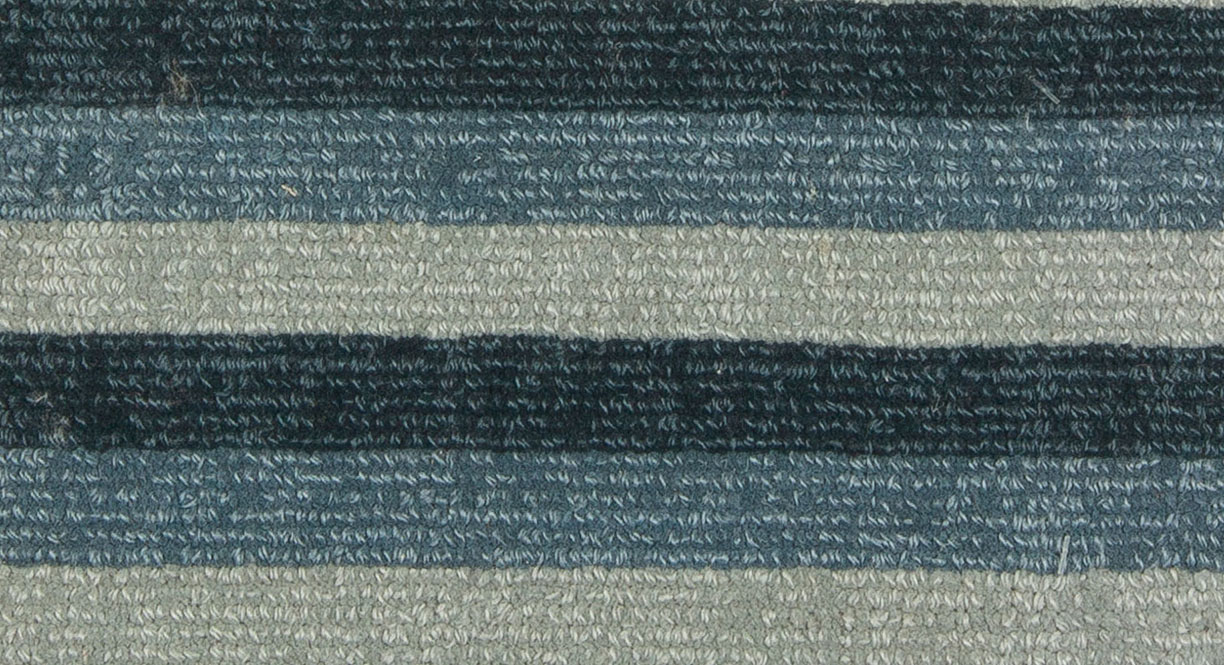
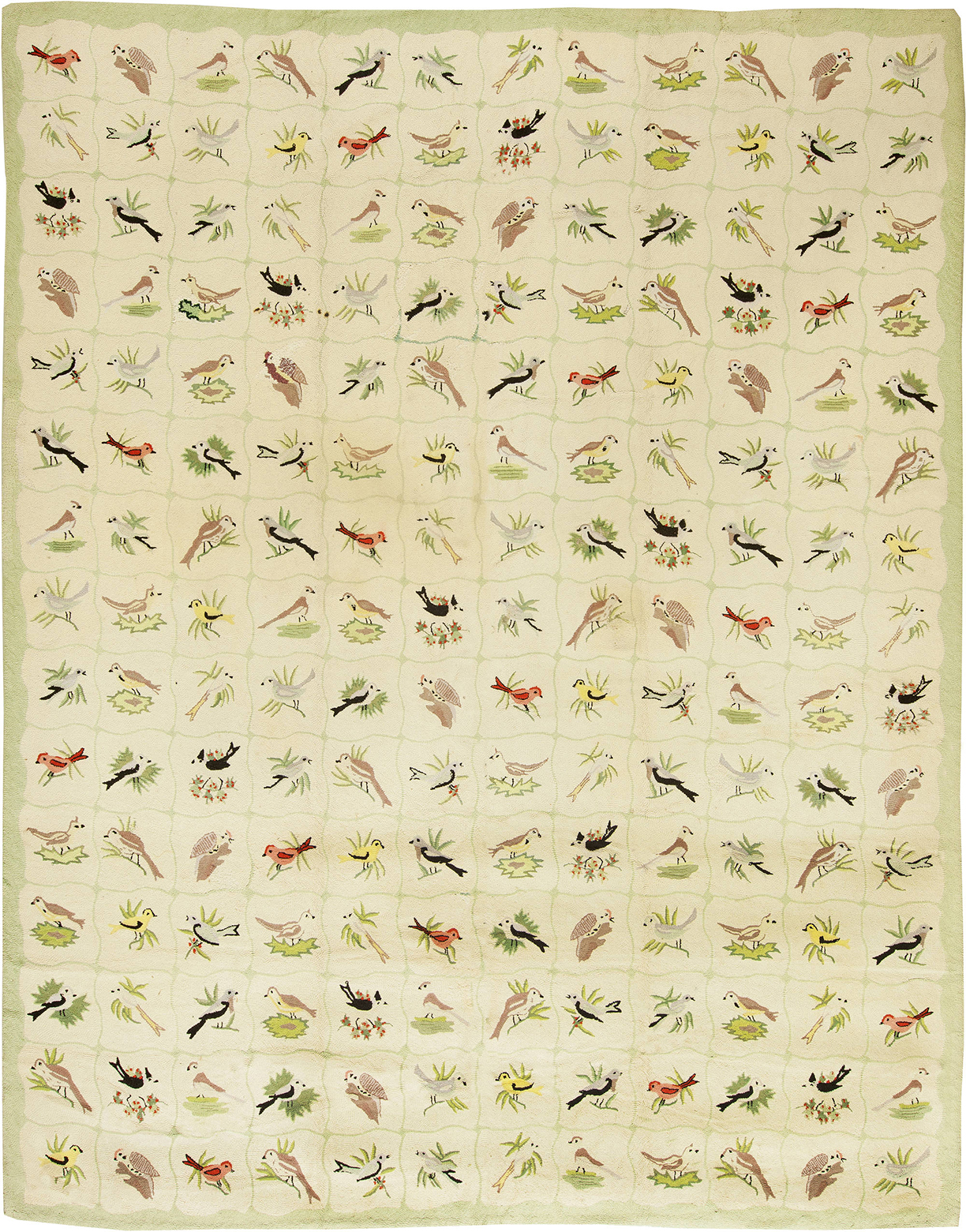
Flat-Woven Rugs
Basic and attractive, these rugs are popular across the globe. The maintenance is low and the rug itself is light and flexible, yet durable. Most are made to be reviserbale, which extends its lifespan even further.
Needlework Rugs
Embroidery fans rejoice! These rugs are large needlepointed masterpieces, with an antique look yet a dependable weave that will last years in the home.

Photos courtesy of Doris Leslie Blau
Being an innovator such a unique and artistic industry as design and architecture takes time and extraordinary effort. To showcase the innovative women making large strides in this business, CovetED Magazine recently highlighted 25 of the most influential women in both design and architecture on their blog.
Zaha Hadid
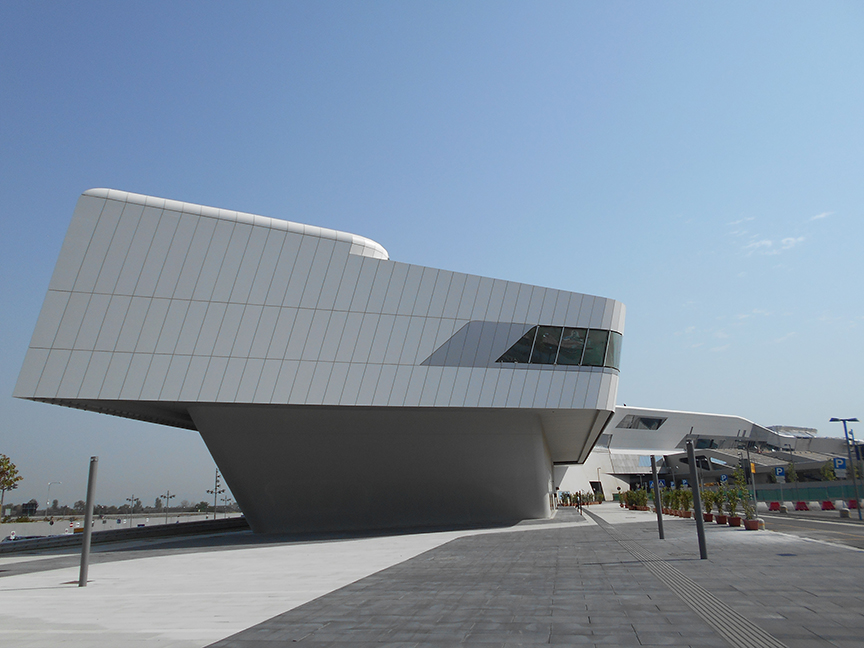
Zaha Hadid, the iconic Iranian-British architect known for her powerful, neo-futuristic creations and exemplary architecture. Though her passing in 2016 has left the world with one less imaginative spirit, her artistic views exist in her projects and their impact on those who see or benefit from them.
One of these projects includes the Napoli-Afragola high-speed train station that provides a key interchange hub for four high-speed train lines. Located only 7.5 miles from Naples, these lines will link the north and south sections of the country.
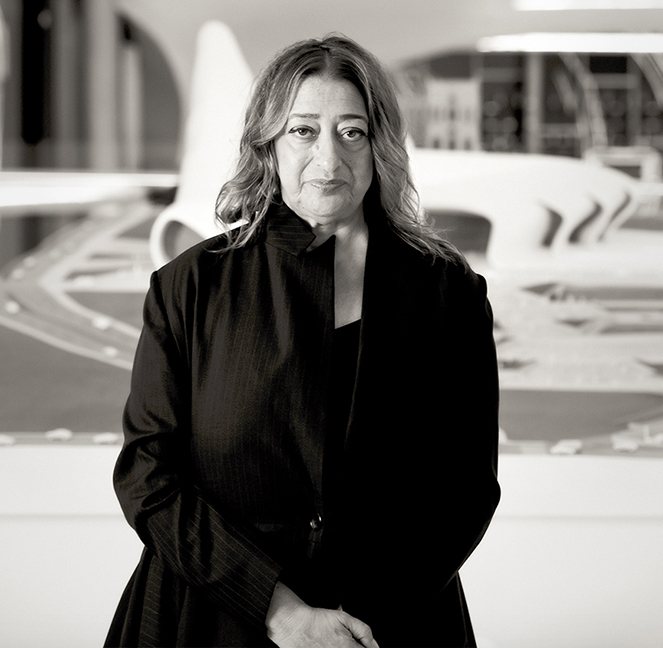
Headshot photo credit: Dmitry Ternovoy. Train station photo credit: Pivari.com
Kelly Wearstler
Interior designer Kelly Wearstler also ranks highly on the list. Known for her aesthetics in modern California luxury, Wearstler’s business has grown remarkably since the early ’90s from a boutique interior design firm to a global lifestyle brand, with designs in lighting, fabrics and furniture in both residential and commercial spaces. Artistic pieces like this gold sculpture showcase a bold, unique presence that makes a statement.
Neri Oxman
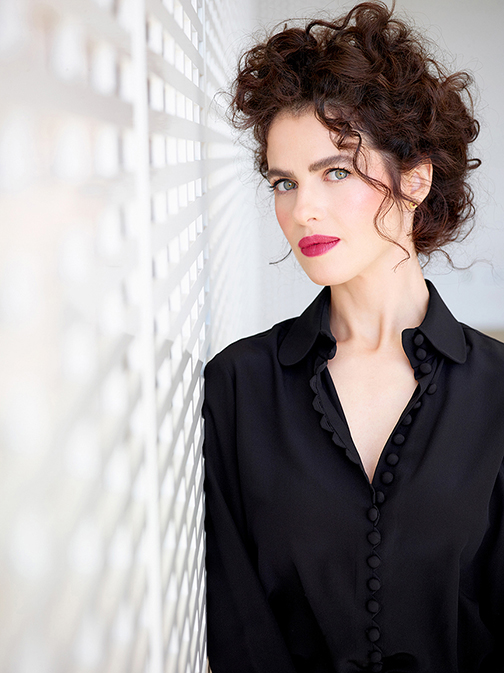
Architect, designer and inventor Neri Oxman is known for making her own statements in both the architectural and scientific fields of study. As Sony Corporation Career Development Professor and Associate Professor of Media Arts and Sciences at the MIT Media Lab, Oxman has coined the term material ecology, which considers “computation, fabrication, and the material itself as inseparable dimensions of design.
In this approach, products and buildings are biologically informed and digitally engineered by, with and for, Nature,” according to her website.
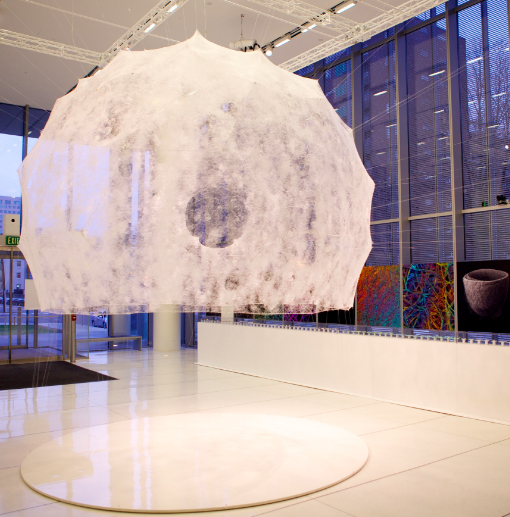
Some of Oxman’s work is included in permanent collections at the Museum of Modern Art, the Smithsonian Institute, the Boston Museum of Fine Arts and other prestigious organizations. The MIT Media Lab features one of her structures titled Silk Pavilion, created using an algorithm that replicates a silkworm’s biological silk-spinning methods.
Photos courtesy Neri Oxman.
See CovetED Magazine’s full list of 25 female innovators in the link below!


